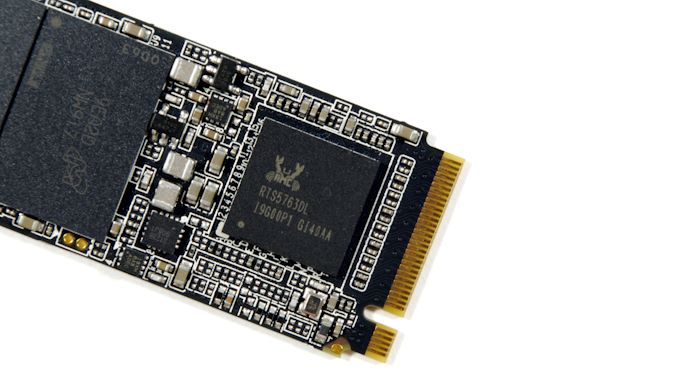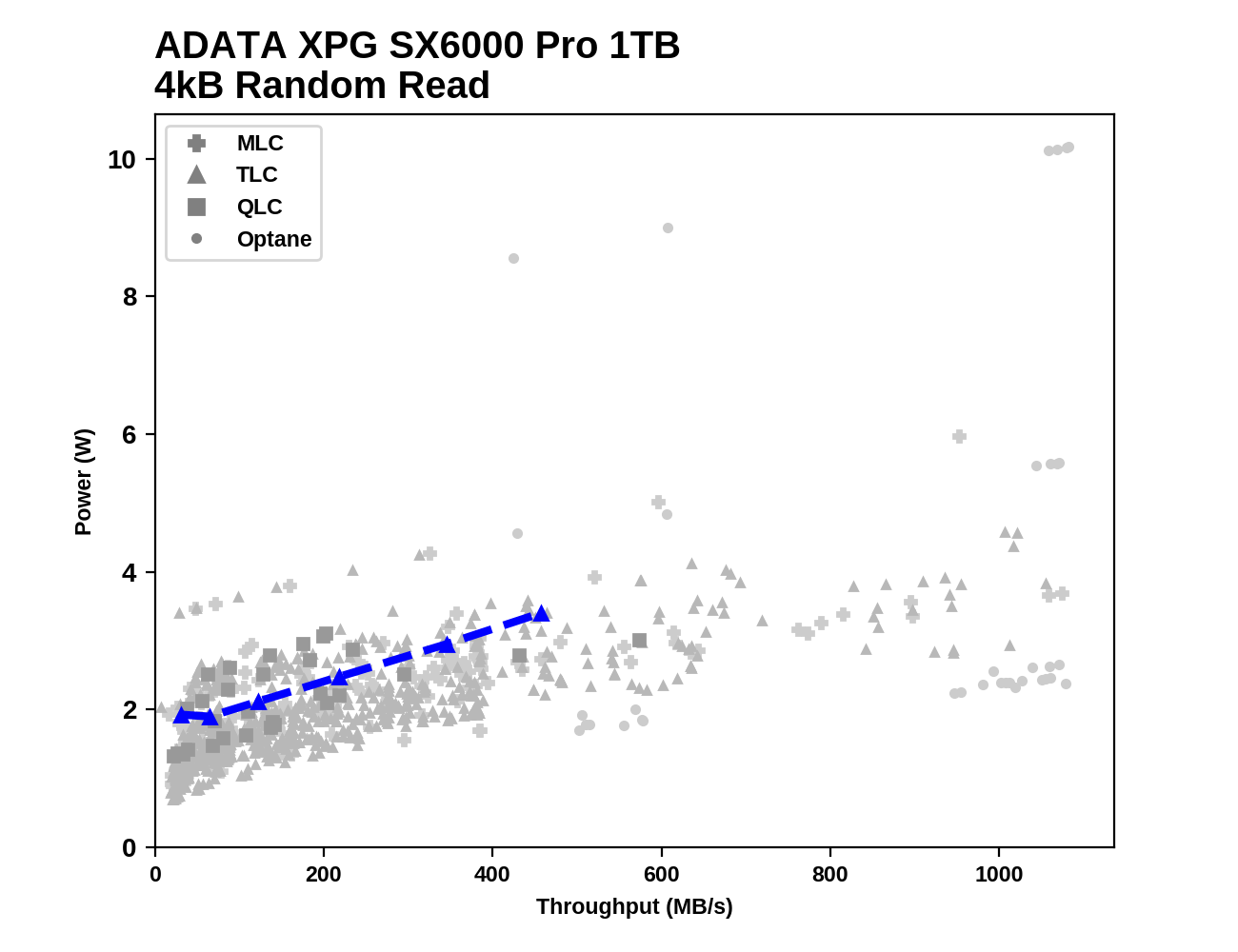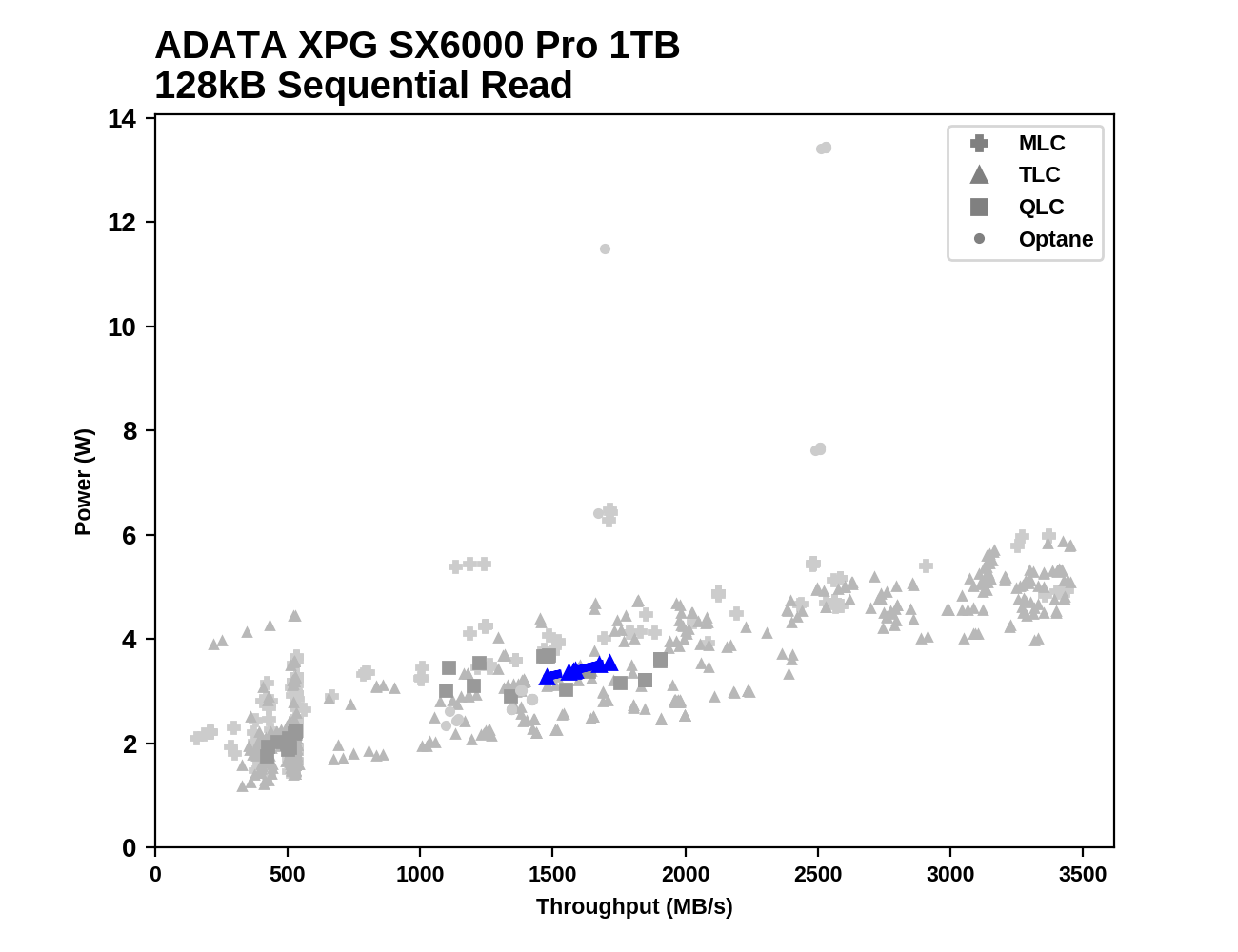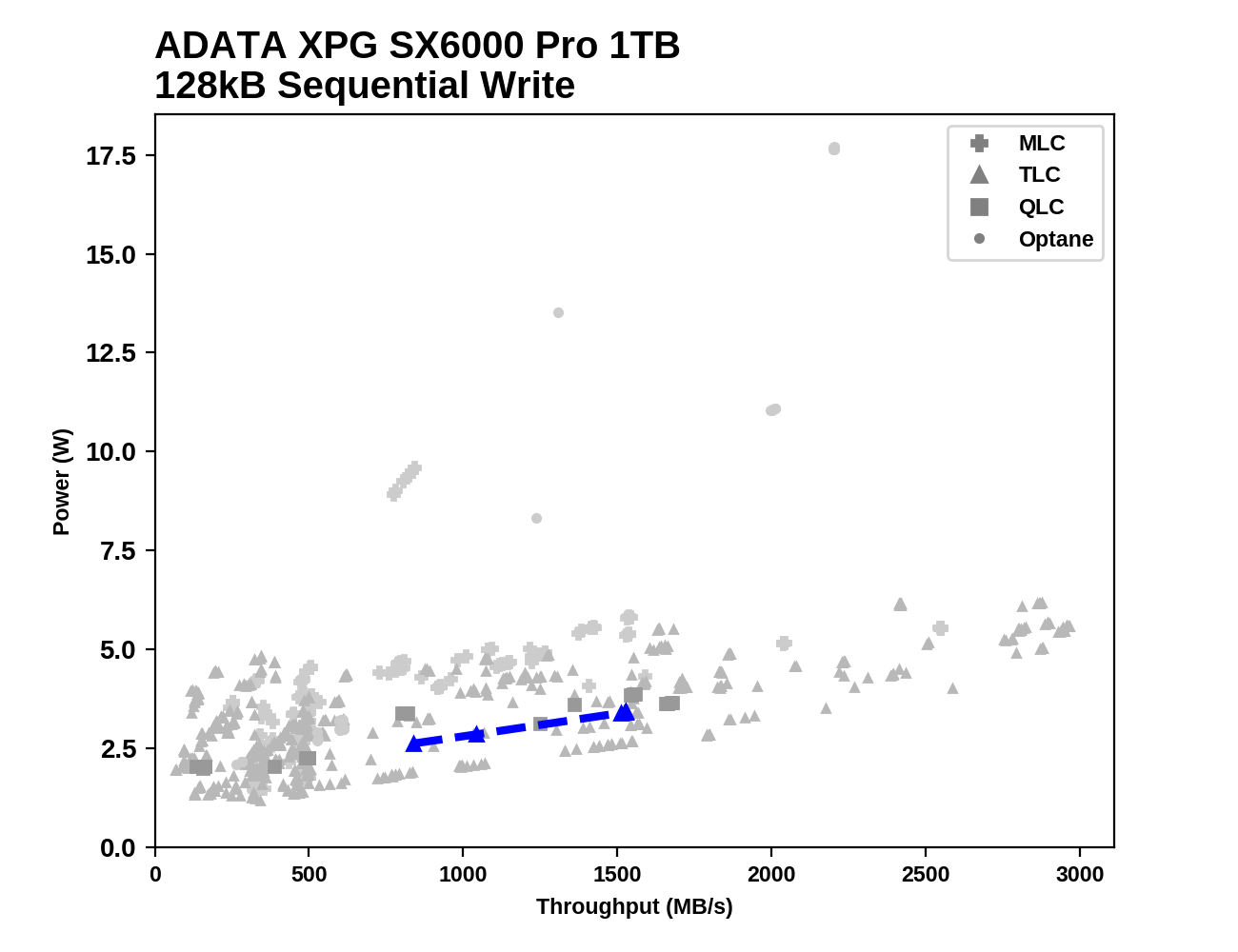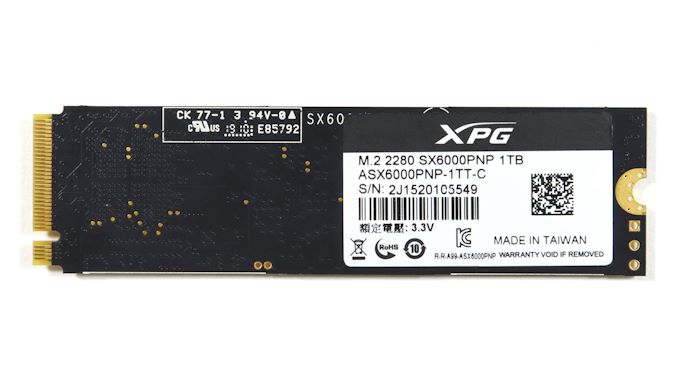
Original Link: https://www.anandtech.com/show/15139/the-adata-xpg-sx6000-pro-1tb-ssd-review
The ADATA XPG SX6000 Pro 1TB SSD Review: Realtek's Entry-level NVMe Solution
by Billy Tallis on December 18, 2019 12:30 PM EST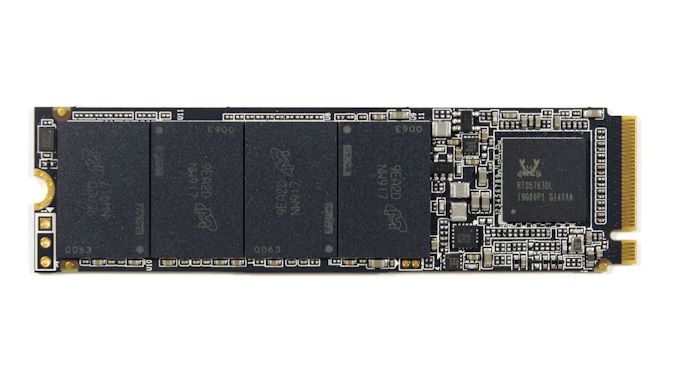
Continuing our dive into newcomer Realtek's SSD controller lineup thanks to several ADATA products, we turn to the ADATA XPG SX6000 Pro, an entry-level NVMe SSD.
As mentioned in our previous SSD review, Realtek is a well-known PC components supplier that is relatively new to the SSD controller business. ADATA has provided Realtek with their most significant SSD design wins, starting with the original SX6000 that used Realtek's very first SSD controller, the RTS5760. The SX6000 Pro targets the same entry-level NVMe market segment, but switches to the second-generation RTS5763DL controller. That newer controller brings a desperately-needed process shrink to enable an upgraded PCIe link and much better performance and power efficiency.
As a late entrant to the SSD market, Realtek is focusing primarily on NVMe rather than SATA. Given that they also prefer to be the low-cost, high-volume alternative rather than pursue high-end niches, the RTS5763DL is probably the most important SSD controller in their current lineup. This controller has a four-channel NAND interface, four PCIe lanes and no DRAM controller, so at a high level it is on par with the Silicon Motion SM2263XT and the upcoming Phison E13T.
ADATA has paired the Realtek controller with Micron's 64-layer 512Gbit TLC NAND, organized as four packages with four dies each for our 1TB sample, all on one side of the M.2 card thanks to the small size of the controller and the lack of an extra DRAM package. The use of 512Gb instead of 256Gb dies cuts costs slightly, but is usually avoided on high-end drives because having fewer dies limits the degree of parallelism available to the SSD controller. This isn't a problem for the 1TB SX6000 Pro since the four-channel controller is a bigger limitation. Since the 256GB and 512GB models of the SX6000 Pro don't have severely curtailed performance specs, ADATA may have made the smart choice to use the 256Gb dies on at least the smallest model.
| ADATA XPG SX6000 Pro Specifications | |||||
| Capacity | 256 GB | 512 GB | 1 TB | ||
| Form Factor | single-sided M.2 2280 PCIe 3.0 x4 | ||||
| Controller | Realtek RTS5763DL | ||||
| NAND Flash | Micron 64L 3D TLC | ||||
| DRAM | None (HMB Supported) | ||||
| Sequential Read | 2100 MB/s | 2100 MB/s | 2100 MB/s | ||
| Sequential Write | 1200 MB/s | 1500 MB/s | 1500 MB/s | ||
| Random Read | 190k IOPS | 250k IOPS | 250k IOPS | ||
| Random Write | 180k IOPS | 240k IOPS | 240k IOPS | ||
| Idle Power | 0.14 W | ||||
| Warranty | 5 years | ||||
| Write Endurance | 150 TB 0.3 DWPD |
300 TB 0.3 DWPD |
600 TB 0.3 DWPD |
||
| Current Retail Price | $39.99 (16¢/GB) |
$77.88 (15¢/GB) |
$119.99 (12¢/GB) |
||
For SATA SSDs, the lack of a DRAM cache pretty much always condemns a drive to have extreme low-end performance. For NVMe SSD, going DRAMless doesn't carry such a harsh penalty and entry-level NVMe SSDs usually have no trouble offering better real-world performance than mainstream SATA SSDs with DRAM caches. This is often achieved with the help of the NVMe Host Memory Buffer feature that lets the SSD borrow a chunk of the host system's DRAM (64 MB in the case of this drive) to use as a cache for the drive's internal data structures used for managing the flash memory. However, toggling HMB on and off didn't produce a meaningful performance difference for any of our tests on the SX6000 Pro, which leaves us questioning whether ADATA and Realtek enabled the feature just to check a box on the spec sheet. We can't actually directly observe the drive's use of HMB without a PCIe bus analyzer, but regardless of how (or if) the SX6000 Pro is making use of HMB, the lack of a measurable effect means we're only bothering to graph the results from our test runs with HMB on, which is the default for any recent OS.
As usual, ADATA bundles the SX6000 Pro with a thin heatspreader that the user can apply if desired, which we never do for regular reviews. ADATA is also selling the same drive as the XPG GAMMIX S5, which has a slightly fancier heatsink pre-installed.
The Competition
We have tested several other entry-level NVMe SSDs that are in direct competition with the SX6000 Pro. The Mushkin Helix-L uses the Silicon Motion SM2263XT controller, another DRAMless 4-channel design with HMB support. The Intel 660p (and the newer 665p) use the SM2263 with DRAM, and use QLC NAND instead of TLC. The Toshiba (now Kioxia) BG4 doesn't currently have a retail version, but it's a popular OEM SSD that likewise is DRAMless.
Phison's entry-level NVMe solutions are missing from this comparison because their E8T controller is pretty old and unpopular at this point, and drives using the successor E13T and E19T controllers haven't quite hit the market. The recently-released WD Blue SN550 adds the 1TB option that the earlier SN500 lacked. These two drives are particularly interesting because they are DRAMless NVMe SSDs that don't use the Host Memory Buffer feature, but our test results from the 250GB SN500 don't really provide a fair comparison against 1TB drives.
As always, it's important to keep an eye on how entry-level NVMe drives perform relative to the more popular high-end models with 8-channel controllers and full-size DRAM caches, because the cheapest high-end drives are usually priced pretty close to entry-level NVMe SSDs. And lastly, representing the SATA SSD market segment, we include the Crucial MX500 as the mainstream choice, and the ADATA Ultimate SU750 featuring Realtek's DRAMless 2-channel SATA controller.
| AnandTech 2018 Consumer SSD Testbed | |
| CPU | Intel Xeon E3 1240 v5 |
| Motherboard | ASRock Fatal1ty E3V5 Performance Gaming/OC |
| Chipset | Intel C232 |
| Memory | 4x 8GB G.SKILL Ripjaws DDR4-2400 CL15 |
| Graphics | AMD Radeon HD 5450, 1920x1200@60Hz |
| Software | Windows 10 x64, version 1709 |
| Linux kernel version 4.14, fio version 3.6 | |
| Spectre/Meltdown microcode and OS patches current as of May 2018 | |
- Thanks to Intel for the Xeon E3 1240 v5 CPU
- Thanks to ASRock for the E3V5 Performance Gaming/OC
- Thanks to G.SKILL for the Ripjaws DDR4-2400 RAM
- Thanks to Corsair for the RM750 power supply, Carbide 200R case, and Hydro H60 CPU cooler
- Thanks to Quarch for the HD Programmable Power Module and accessories
- Thanks to StarTech for providing a RK2236BKF 22U rack cabinet.
Whole-Drive Fill
This test starts with a freshly-erased drive and fills it with 128kB sequential writes at queue depth 32, recording the write speed for each 1GB segment. This test is not representative of any ordinary client/consumer usage pattern, but it does allow us to observe transitions in the drive's behavior as it fills up. This can allow us to estimate the size of any SLC write cache, and get a sense for how much performance remains on the rare occasions where real-world usage keeps writing data after filling the cache.
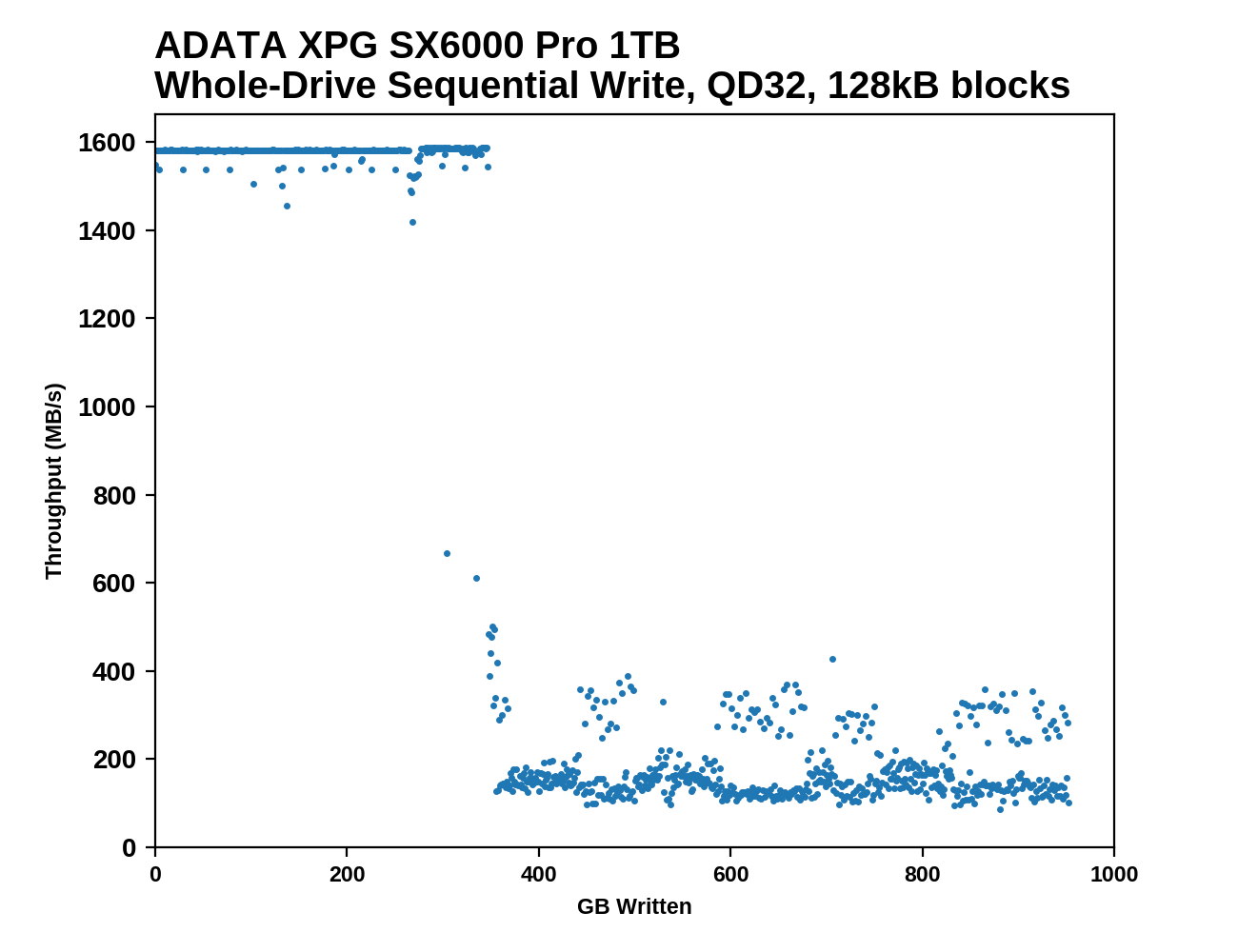 |
|||||||||
As with the Realtek-based ADATA SU750, the ADATA SX6000 Pro shows a large SLC cache and a sudden performance drop when it runs out. Since the SX6000 Pro's RTS5763DL controller is a 4-channel design compared to the 2-channel RTS5733, the post-SLC write speed is quite a bit faster than the SU750, but it's also less consistent. Aside from a few momentary drops during the SLC phase, the cache lasts for about 348GB of writes, which is pretty much the largest SLC cache size possible with 1TB of TLC NAND. The write speed to the SLC cache is just a hair faster than the advertised 1.5GB/s.
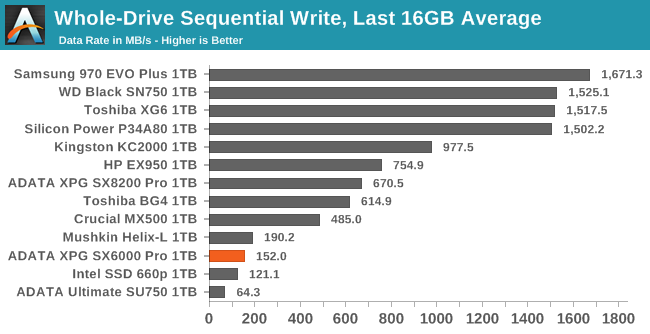 |
|||||||||
| Average Throughput for last 16 GB | Overall Average Throughput | ||||||||
The post-SLC write speed from the SX6000 Pro is over twice as fast as the ADATA SU750 and is ahead of the Intel 660p, but is not up to the speed of the Mushkin Helix-L. And the Toshiba BG4 shows that DRAMless drives don't have to be anywhere near this slow; the BG4 is 3-4 times faster after its admittedly small SLC cache runs out.
Working Set Size
Most mainstream SSDs have enough DRAM to store the entire mapping table that translates logical block addresses into physical flash memory addresses. DRAMless drives only have small buffers to cache a portion of this mapping information. Some NVMe SSDs (the SX6000 Pro included) support the Host Memory Buffer feature and can borrow a piece of the host system's DRAM for this cache rather needing lots of on-controller memory.
When accessing a logical block whose mapping is not cached, the drive needs to read the mapping from the full table stored on the flash memory before it can read the user data stored at that logical block. This adds extra latency to read operations and in the worst case may double random read latency.
We can see the effects of the size of any mapping buffer by performing random reads from different sized portions of the drive. When performing random reads from a small slice of the drive, we expect the mappings to all fit in the cache, and when performing random reads from the entire drive, we expect mostly cache misses.
When performing this test on mainstream drives with a full-sized DRAM cache, we expect performance to be generally constant regardless of the working set size, or for performance to drop only slightly as the working set size increases.
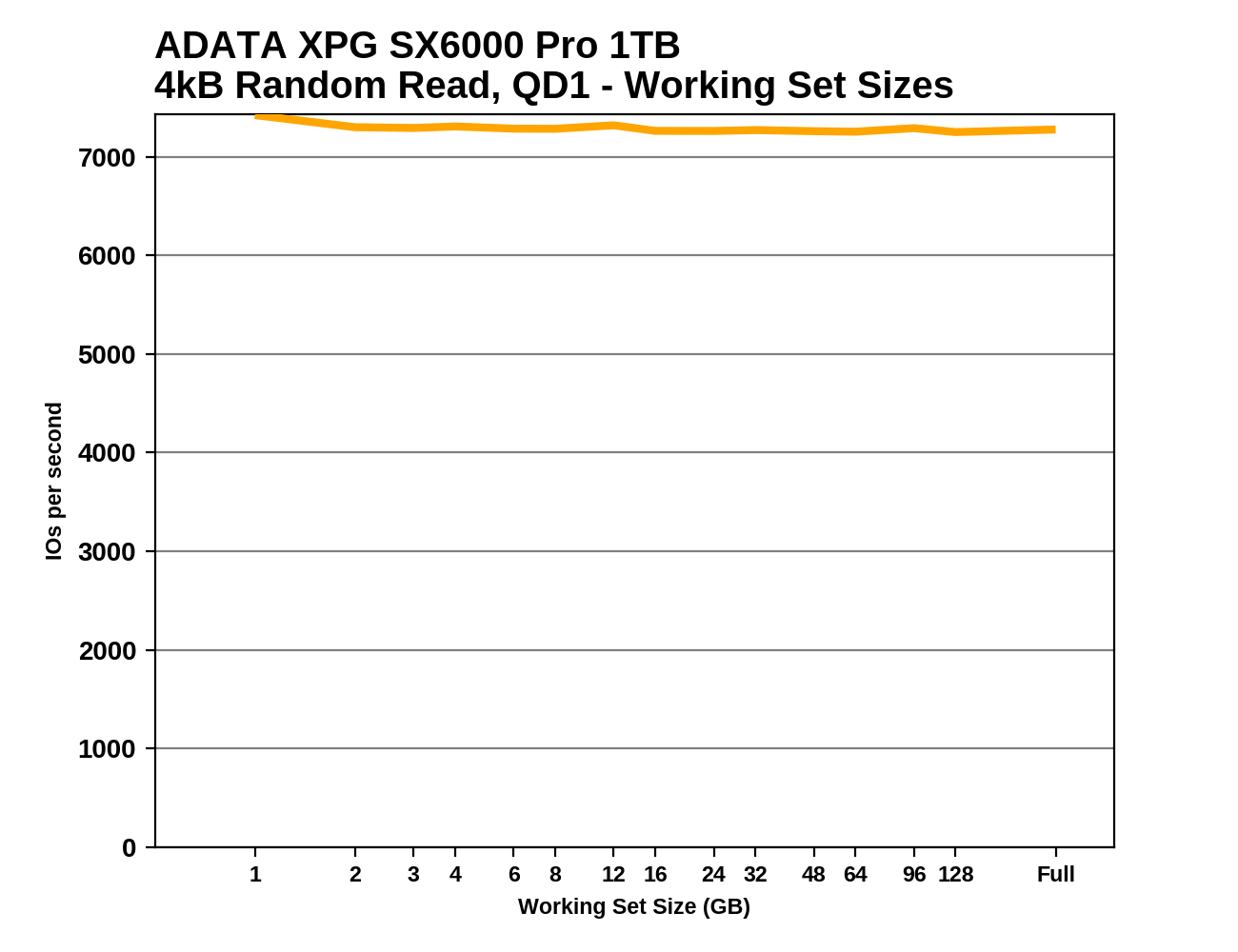 |
|||||||||
The ADATA SX6000 Pro shows very consistent QD1 random read performance regardless of the test's working set size, so it appears that it is not deriving any benefit from the NVMe Host Memory Buffer feature, unlike the Toshiba BG4. Nor do we see an obvious cache size effect from on-controller SRAM as with the WD Blue SN500. The SX6000 Pro is not alone in this; the Mushkin Helix-L with Silicon Motion's DRAMless NVMe controller also leaves us largely wondering how HMB earns its keep.
AnandTech Storage Bench - The Destroyer
The Destroyer is an extremely long test replicating the access patterns of very IO-intensive desktop usage. A detailed breakdown can be found in this article. Like real-world usage, the drives do get the occasional break that allows for some background garbage collection and flushing caches, but those idle times are limited to 25ms so that it doesn't take all week to run the test. These AnandTech Storage Bench (ATSB) tests do not involve running the actual applications that generated the workloads, so the scores are relatively insensitive to changes in CPU performance and RAM from our new testbed, but the jump to a newer version of Windows and the newer storage drivers can have an impact.
We quantify performance on this test by reporting the drive's average data throughput, the average latency of the I/O operations, and the total energy used by the drive over the course of the test.
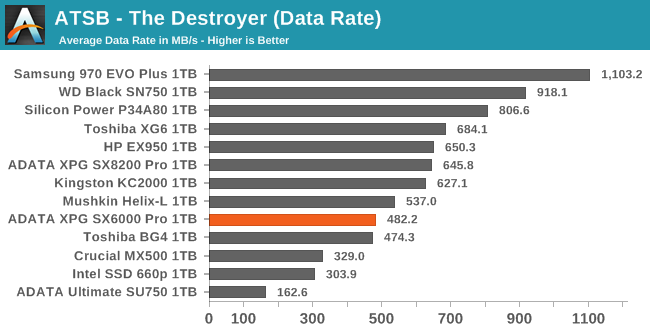
The ADATA SX6000 Pro is a bit slower overall on The Destroyer than the Mushkin Helix-L, but is basically tied with the Toshiba BG4, so it's in the right ballpark for an entry level NVMe drive. The performance is much higher than the SATA drives or the QLC-based Intel 660p.
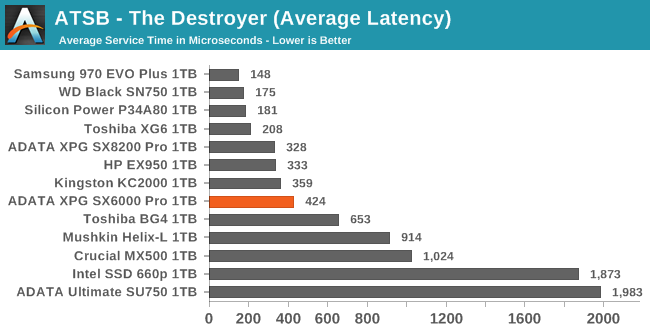
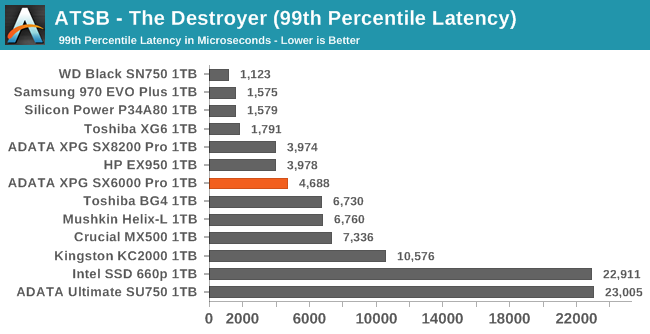
The SX6000 Pro's average and 99th percentile latency scores on The Destroyer are both clearly better than the other entry-level NVMe SSDs in this batch, and are not far behind some of the more affordable high-end drives.
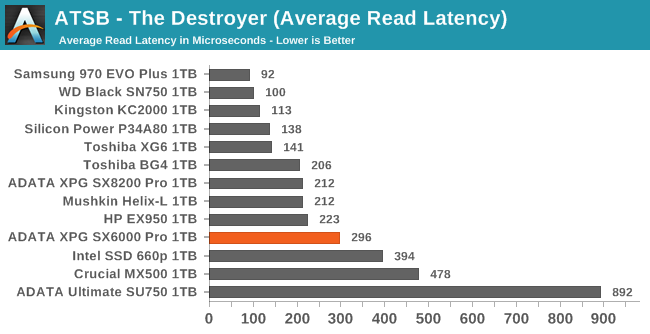
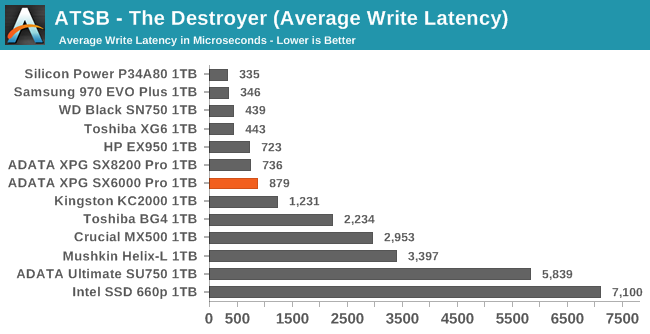
The Toshiba BG4 and Mushkin Helix-L both have moderately better average read latency scores than the SX6000 Pro, but the latter is way ahead when it comes to writes—the SX6000 Pro's average write latency is competitive with several high-end NVMe drives.
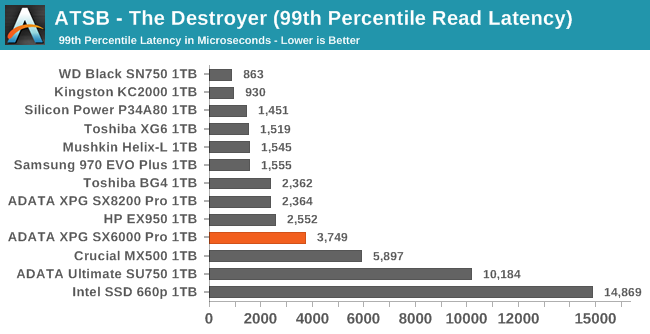
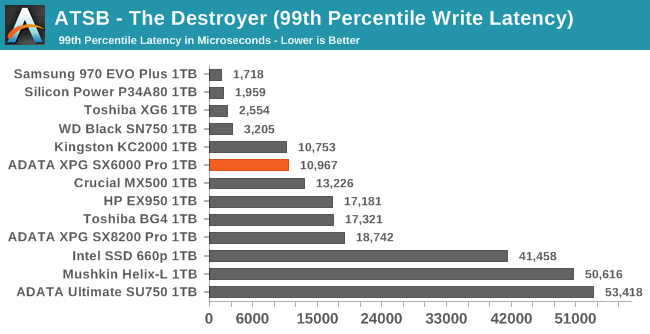
The 99th percentile read latency score for the SX6000 Pro isn't as good as most of the other NVMe drives, but it's still clearly better than the SATA drives or the QLC-based Intel 660p. For writes, the 99th percentile latency can't match the top-tier high-end drives but it is competitive with the high-end drives based on the SM2262EN controller that takes a similarly aggressive approach to SLC caching as the Realtek RTS5763DL.
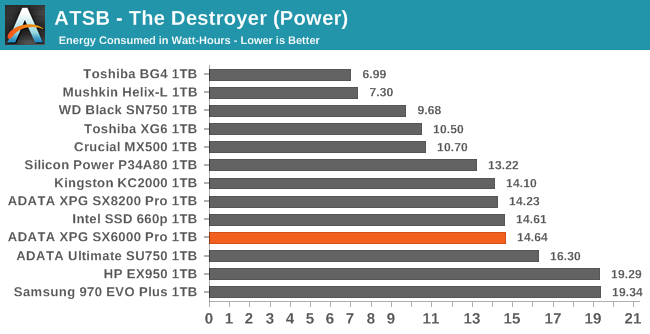
Several of the entry-level NVMe drives we've tested score very well for efficiency over the course of The Destroyer thanks to a combination of decent performance and power savings from the lack of onboard DRAM. This is clearly not the case for the SX6000 Pro. It does use less energy in total than the most power-hungry high-end drives, but the Toshiba BG4 and Mushkin Helix-L both complete the test with comparable overall performance while using less than half as much energy.
AnandTech Storage Bench - Heavy
Our Heavy storage benchmark is proportionally more write-heavy than The Destroyer, but much shorter overall. The total writes in the Heavy test aren't enough to fill the drive, so performance never drops down to steady state. This test is far more representative of a power user's day to day usage, and is heavily influenced by the drive's peak performance. The Heavy workload test details can be found here. This test is run twice, once on a freshly erased drive and once after filling the drive with sequential writes.
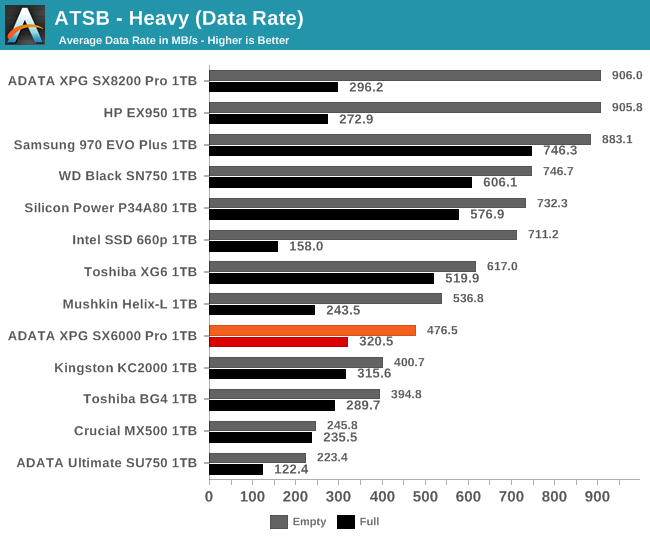
The ADATA SX6000 Pro has decent overall performance on the Heavy test for an entry-level NVMe SSD, and its full-drive performance is the best for this market segment. The Mushkin Helix-L and Intel 660p both use Silicon Motion controllers that offer better peak performance for the empty-drive test runs at the expense of worse full-drive performance (even the high-end SMI-based drives are a bit slower when full than the SX6000 Pro).
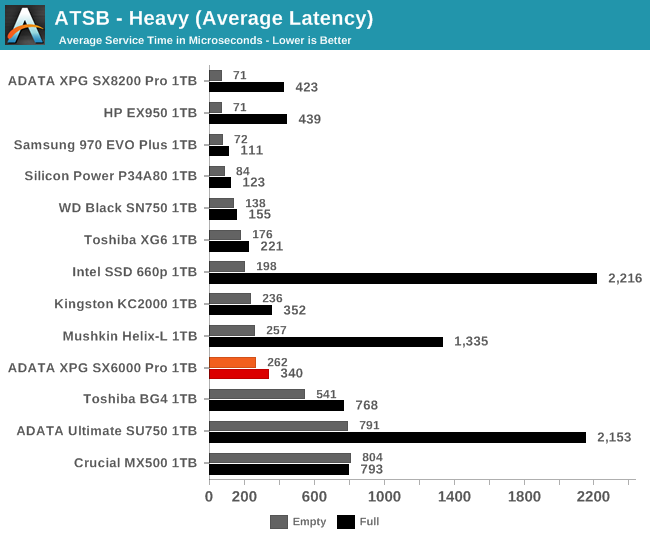
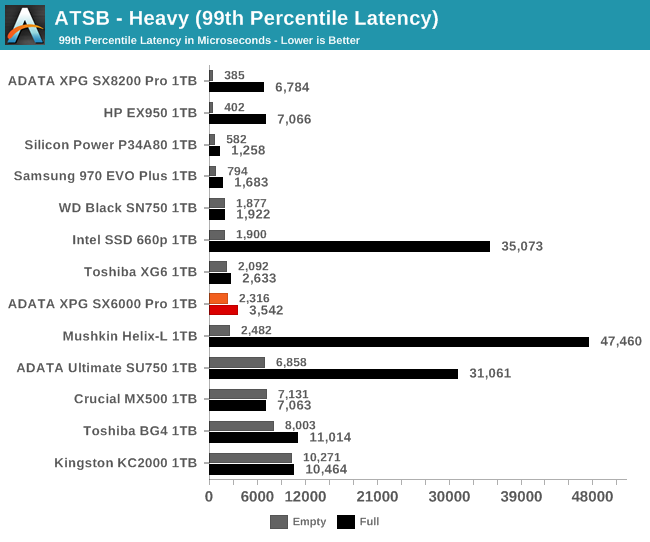
The average and 99th percentile latency scores for the SX6000 Pro are fine: all significantly faster than a mainstream SATA drive, with no huge latency spikes from running the test on a full drive.
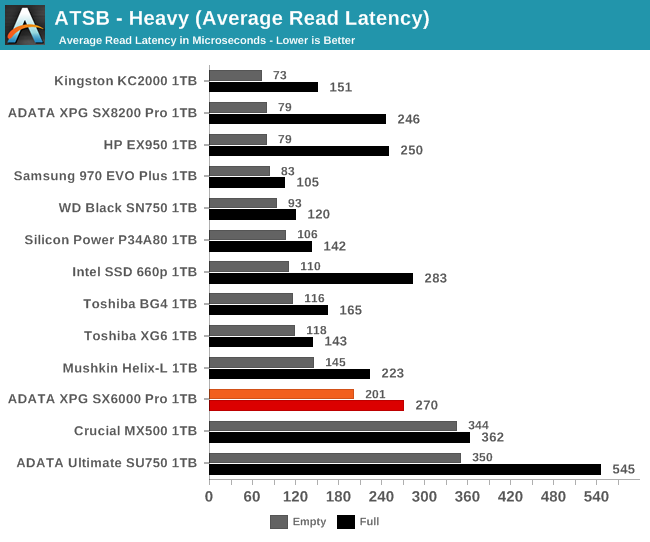
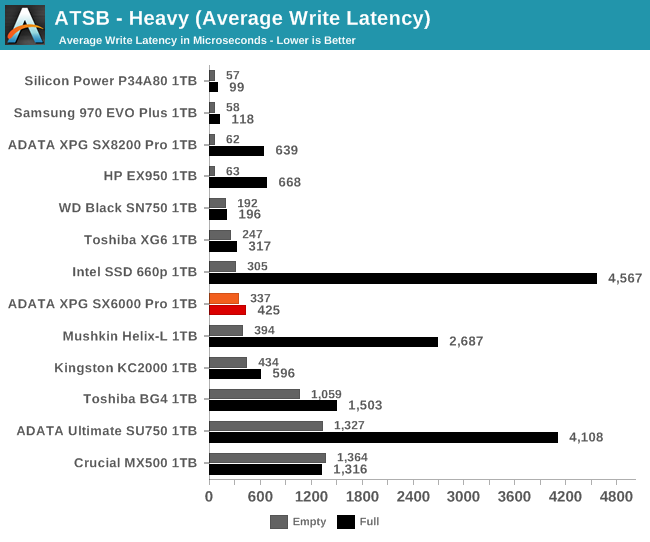
The average latencies from the SX6000 Pro are higher than most NVMe SSDs but still better than SATA. For writes, the SX6000 Pro gets close to some high-end NVMe drives.
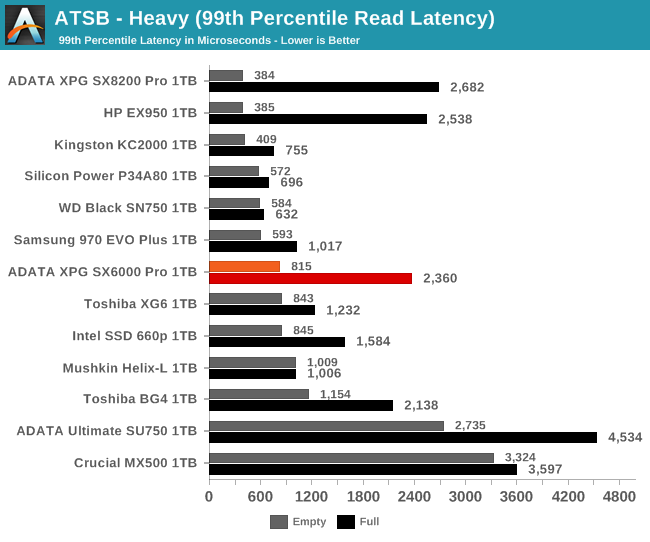
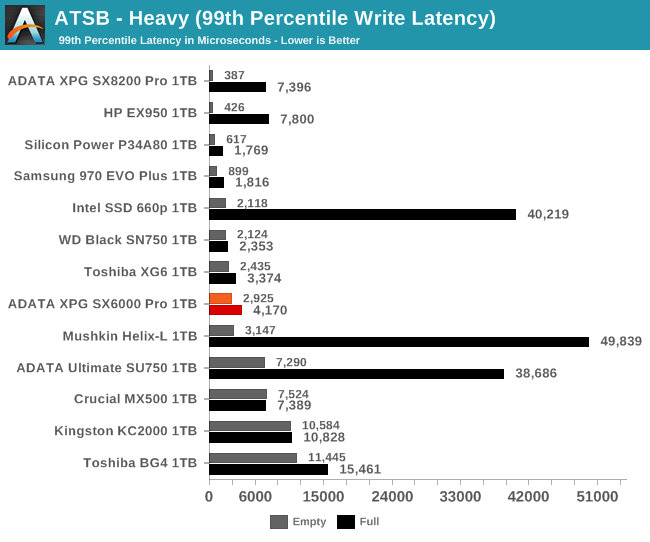
The 99th percentile read latency is the first sign that the SX6000 Pro has some difficulty with handling the Heavy test on a full drive, but the read QoS in that case is still better than the SATA drives. The 99th percentile write latencies are good whether the test is run on a full or empty drive.
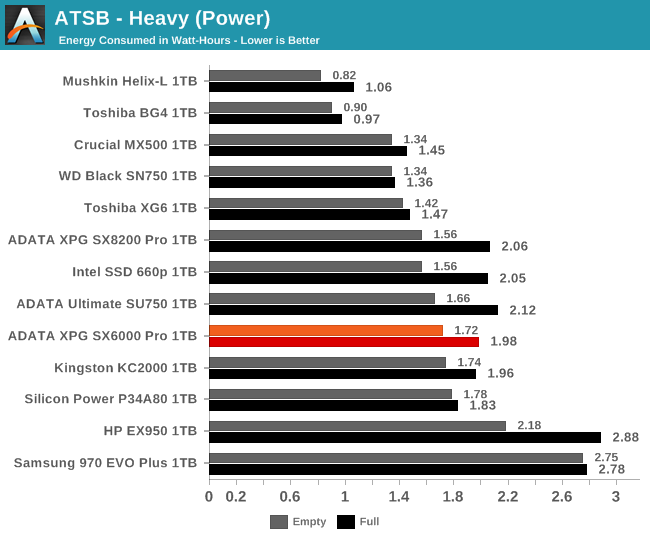
The efficiency scores for the SX6000 Pro are in line with most high-end NVMe SSDs, but the other DRAMless NVMe drives again use half the energy to provide similar performance.
AnandTech Storage Bench - Light
Our Light storage test has relatively more sequential accesses and lower queue depths than The Destroyer or the Heavy test, and it's by far the shortest test overall. It's based largely on applications that aren't highly dependent on storage performance, so this is a test more of application launch times and file load times. This test can be seen as the sum of all the little delays in daily usage, but with the idle times trimmed to 25ms it takes less than half an hour to run. Details of the Light test can be found here. As with the ATSB Heavy test, this test is run with the drive both freshly erased and empty, and after filling the drive with sequential writes.
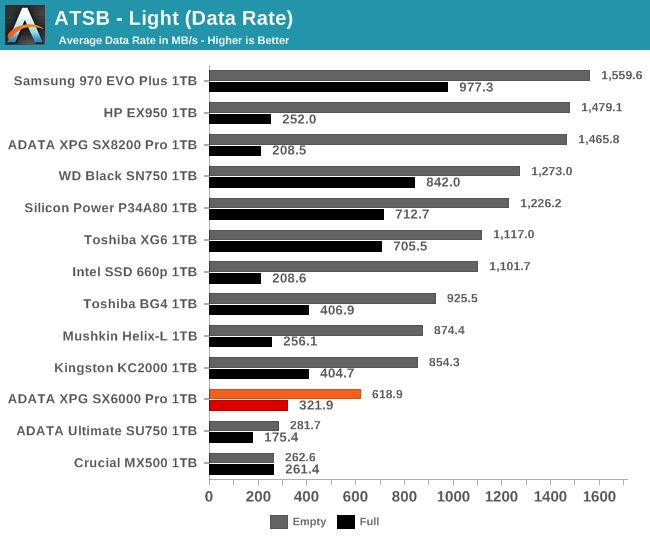
The ADATA XPG SX6000 Pro has the worst overall performance on the Light test out of all the NVMe drives in this batch, though several drives with better peak performance are slower when the test is run on a full drive.
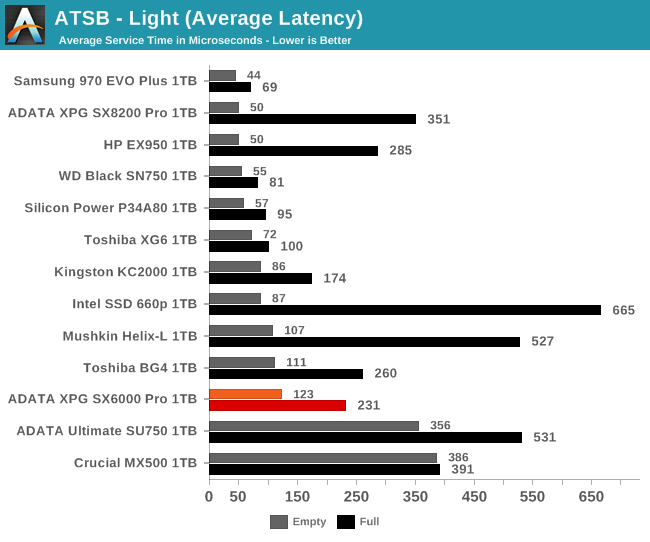
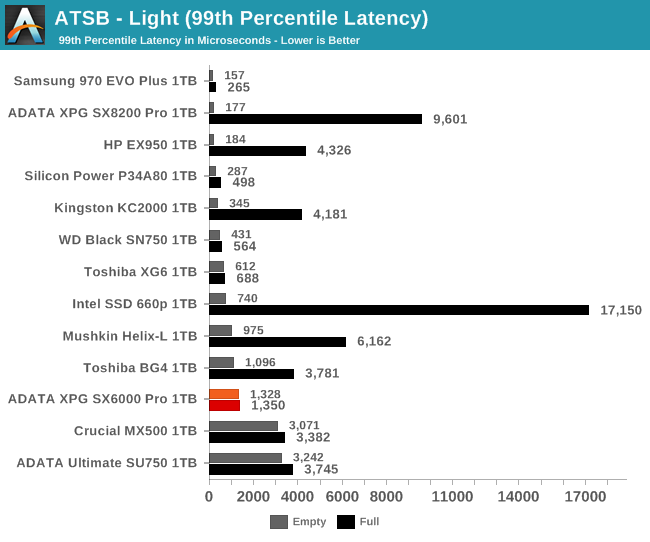
The average and 99th percentile latency scores for the SX6000 Pro are high for a NVMe drive, but it doesn't lose much performance when the test is run on a full drive so those worst-case scores are still better than the SATA drives. Most of the other low-end NVMe SSDs can degrade to SATA or worse performance.
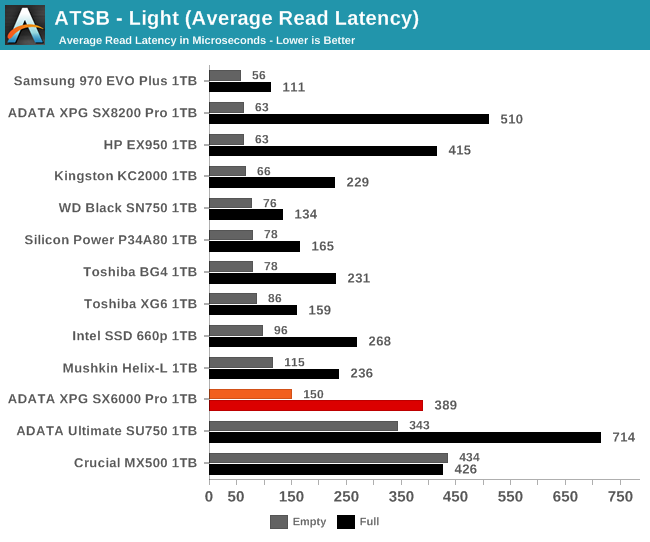
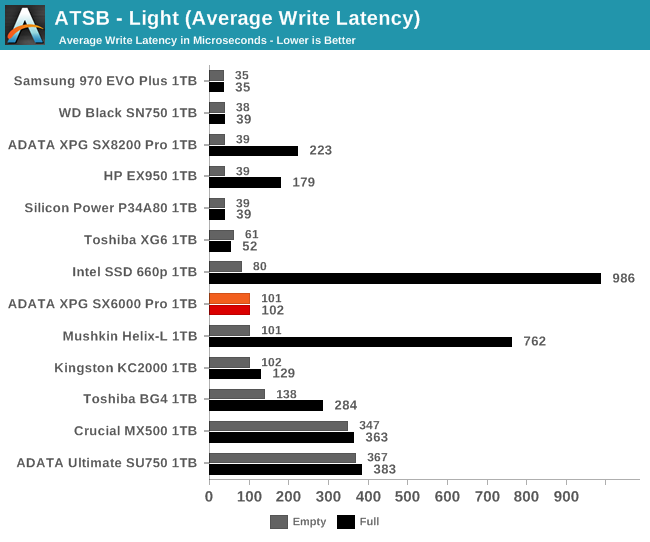
The average read latency of the SX6000 Pro is strongly affected by the drive being full, while the average write latency is completely unaffected. None of the other low-end NVMe drives keep write latency so low when the test is run on a full drive.
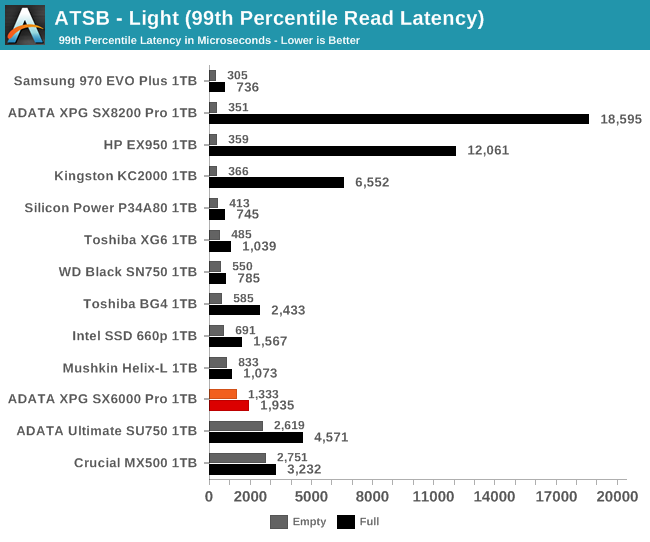
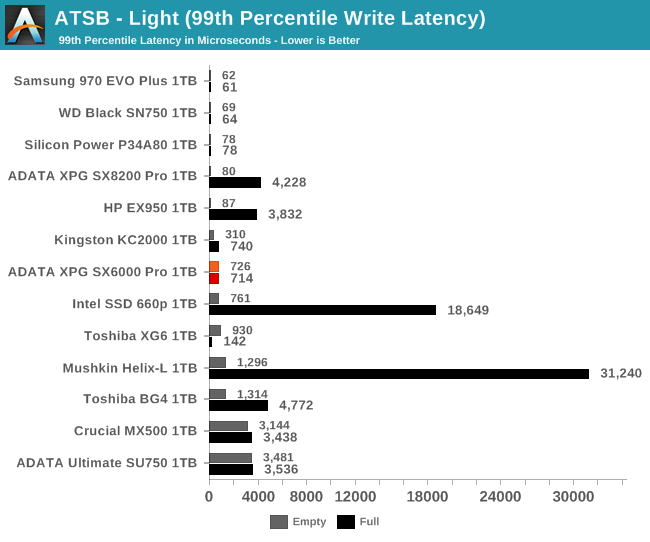
The 99th percentile read and write scores for the SX6000 Pro are all good, but the solid write QoS even for a full drive is impressive.
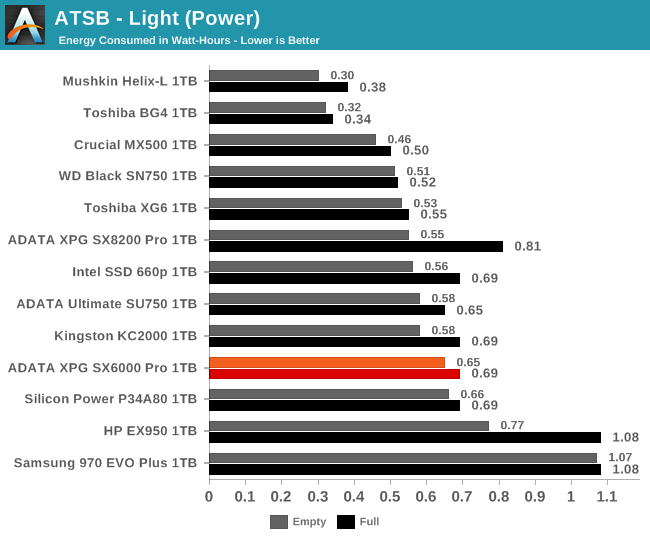
The energy usage of the SX6000 Pro over the course of the Light test is again roughly twice that of the other DRAMless NVMe SSDs, but it's not particularly high when compared to NVMe SSDs in general.
Random Read Performance
Our first test of random read performance uses very short bursts of operations issued one at a time with no queuing. The drives are given enough idle time between bursts to yield an overall duty cycle of 20%, so thermal throttling is impossible. Each burst consists of a total of 32MB of 4kB random reads, from a 16GB span of the disk. The total data read is 1GB.
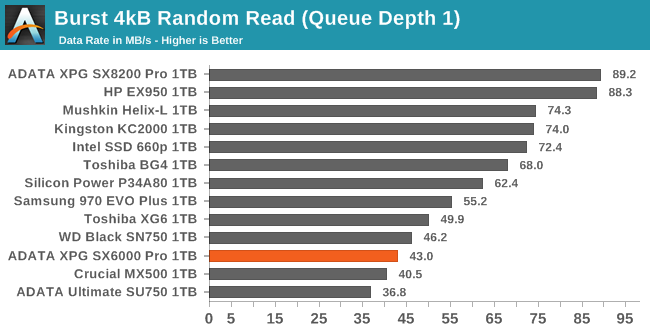
The burst random read performance from the ADATA XPG SX6000 Pro is rather disappointing considering what drives with Silicon Motion controllers get out of the same NAND, but at least it's still a bit faster than the Crucial MX500 SATA drive that also uses Micron 64L TLC.
Our sustained random read performance is similar to the random read test from our 2015 test suite: queue depths from 1 to 32 are tested, and the average performance and power efficiency across QD1, QD2 and QD4 are reported as the primary scores. Each queue depth is tested for one minute or 32GB of data transferred, whichever is shorter. After each queue depth is tested, the drive is given up to one minute to cool off so that the higher queue depths are unlikely to be affected by accumulated heat build-up. The individual read operations are again 4kB, and cover a 64GB span of the drive.
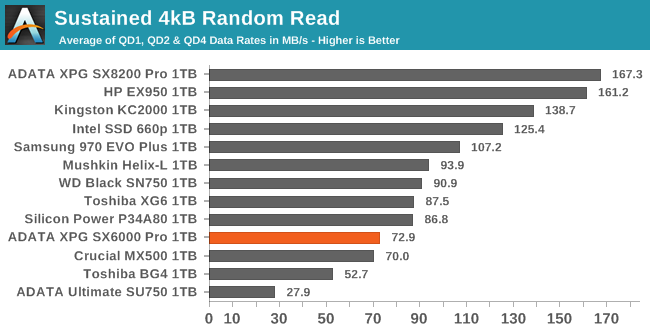
The SX6000 Pro ranks about the same on the longer random read test, but this level of performance is more expected here given that it's a DRAMless SSD. However, the Mushkin Helix-L is in the same boat and still manages to be 28% faster.
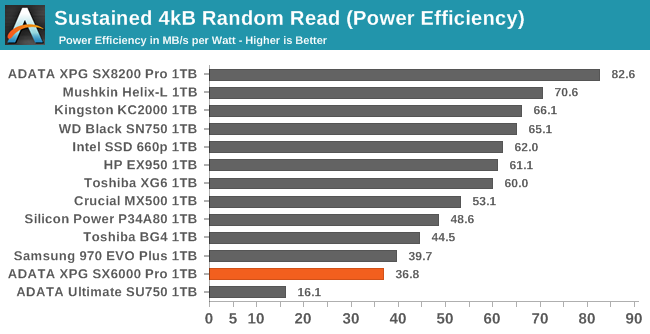 |
|||||||||
| Power Efficiency in MB/s/W | Average Power in W | ||||||||
Realtek's SSD controllers are still in last place for power efficiency, but the efficiency score for the SX6000 Pro is only a bit worse than for the Samsung 970 EVO Plus. The power draw of just under 2W is in the normal range for NVMe SSDs in general, but the other low-end drives draw closer to 1W.
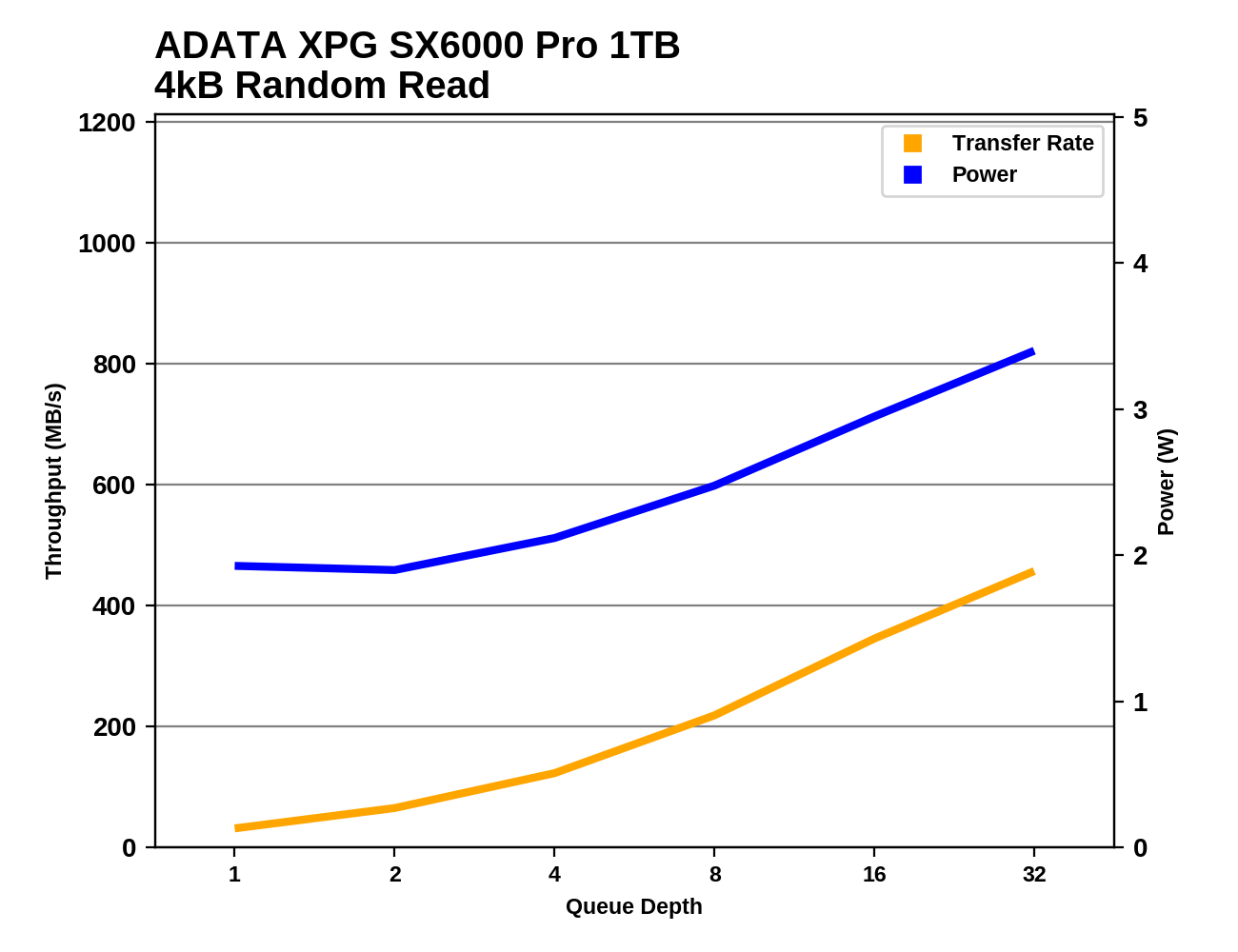 |
|||||||||
The random read performance of the SX6000 Pro starts out slow at QD1 but it scales up reasonably well for a 4-channel controller. Unfortunately, power consumption also scales up, so even at higher queue depths it is still relatively inefficient.
With a high enough queue depth, the random read performance of the SX6000 Pro does climb out of SATA territory, but not by much. It definitely draws more power than most drives across the entire range of tested queue depths, but isn't quite record-setting.
Random Write Performance
Our test of random write burst performance is structured similarly to the random read burst test, but each burst is only 4MB and the total test length is 128MB. The 4kB random write operations are distributed over a 16GB span of the drive, and the operations are issued one at a time with no queuing.
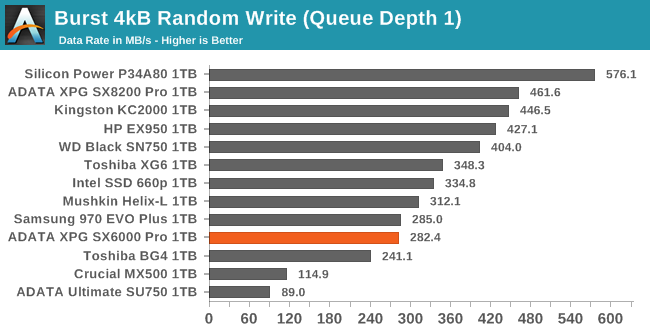
The burst random write performance of the SX6000 Pro is way above what the SATA drives manage, but is on the low side by NVMe standards—even when considering just the low-end NVMe drives.
As with the sustained random read test, our sustained 4kB random write test runs for up to one minute or 32GB per queue depth, covering a 64GB span of the drive and giving the drive up to 1 minute of idle time between queue depths to allow for write caches to be flushed and for the drive to cool down.
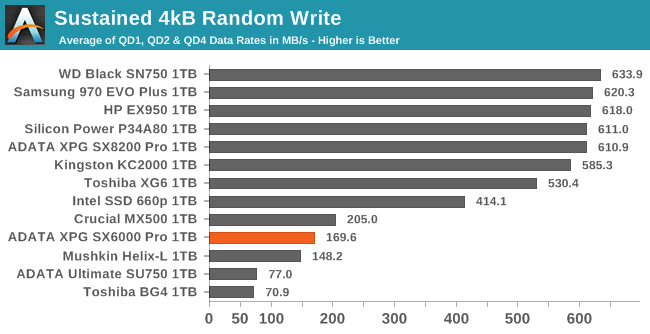
On the longer random write test, the SX6000 Pro falls far behind the high-end NVMe drives and is a bit slower than the Crucial MX500 SATA SSD. The SX6000 Pro is the fastest of the DRAMless drives in this bunch, but the Intel 660p's strategy of using QLC NAND with DRAM makes it by far the fastest low-end NVMe drive on this test.
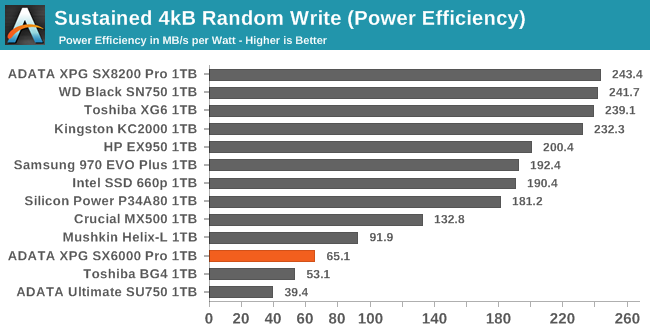 |
|||||||||
| Power Efficiency in MB/s/W | Average Power in W | ||||||||
The SX6000 Pro is the fastest DRAMless drive on this test, but it's also by far the most power-hungry, so its efficiency score is significantly worse than that of the Mushkin Helix-L.
 |
|||||||||
Performance and power consumption from the SX6000 Pro are unsteady throughout the random write test, but the overall trend is flat. That plus the fact that lower performance corresponds to higher power consumption shows that the drive is bottlenecked by background work, and it needs more idle time than this test provides.
Since the SX6000 Pro's SLC cache is far less effective for random writes than sequential, and it is slow about completing background maintenance, the drive is stuck firmly in SATA performance territory with power efficiency that is mediocre at best.
Sequential Read Performance
Our first test of sequential read performance uses short bursts of 128MB, issued as 128kB operations with no queuing. The test averages performance across eight bursts for a total of 1GB of data transferred from a drive containing 16GB of data. Between each burst the drive is given enough idle time to keep the overall duty cycle at 20%.

The burst sequential read performance of the ADATA XPG SX6000 Pro is comparable to other entry-level NVMe drives and some of the underperforming high-end drives. It is about three times the performance of SATA SSDs, and just over half the performance of the fastest high-end drives in this batch.
Our test of sustained sequential reads uses queue depths from 1 to 32, with the performance and power scores computed as the average of QD1, QD2 and QD4. Each queue depth is tested for up to one minute or 32GB transferred, from a drive containing 64GB of data. This test is run twice: once with the drive prepared by sequentially writing the test data, and again after the random write test has mixed things up, causing fragmentation inside the SSD that isn't visible to the OS. These two scores represent the two extremes of how the drive would perform under real-world usage, where wear leveling and modifications to some existing data will create some internal fragmentation that degrades performance, but usually not to the extent shown here.
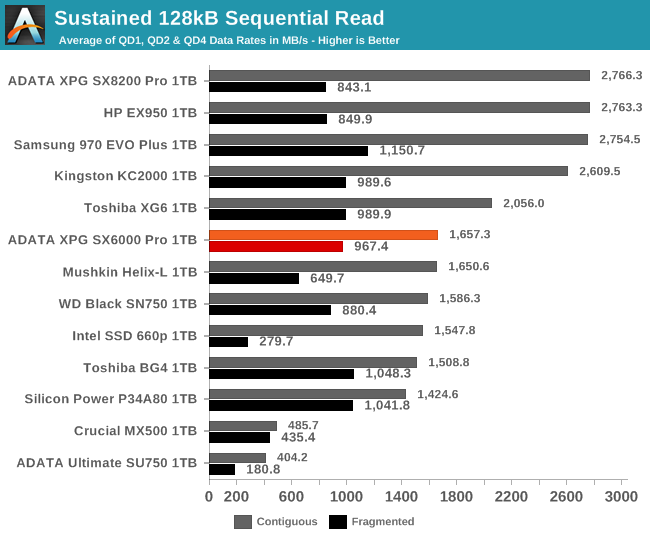
On the longer sequential read test, the SX6000 Pro maintains its good standing. It's not in the top tier of high-end drives, but it is in the second tier that includes some high-end 8-channel+DRAM drives.
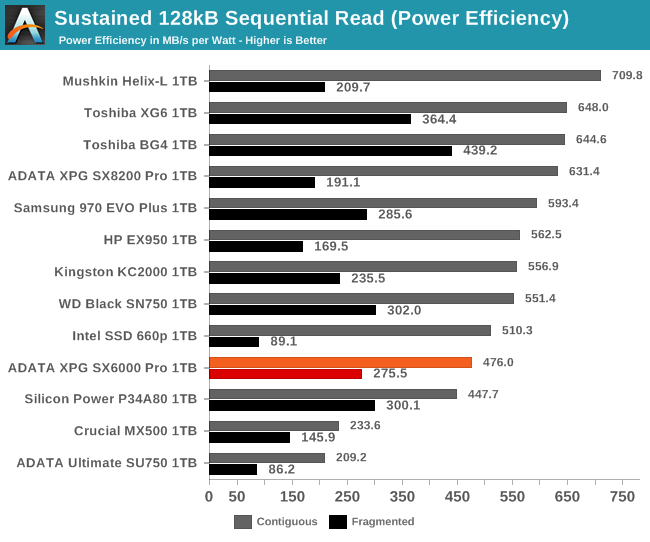 |
|||||||||
| Power Efficiency in MB/s/W | Average Power in W | ||||||||
As usual, the power efficiency of the SX6000 Pro is poor, but for sequential reads it isn't the worst-scoring NVMe drive and it isn't too far below average.
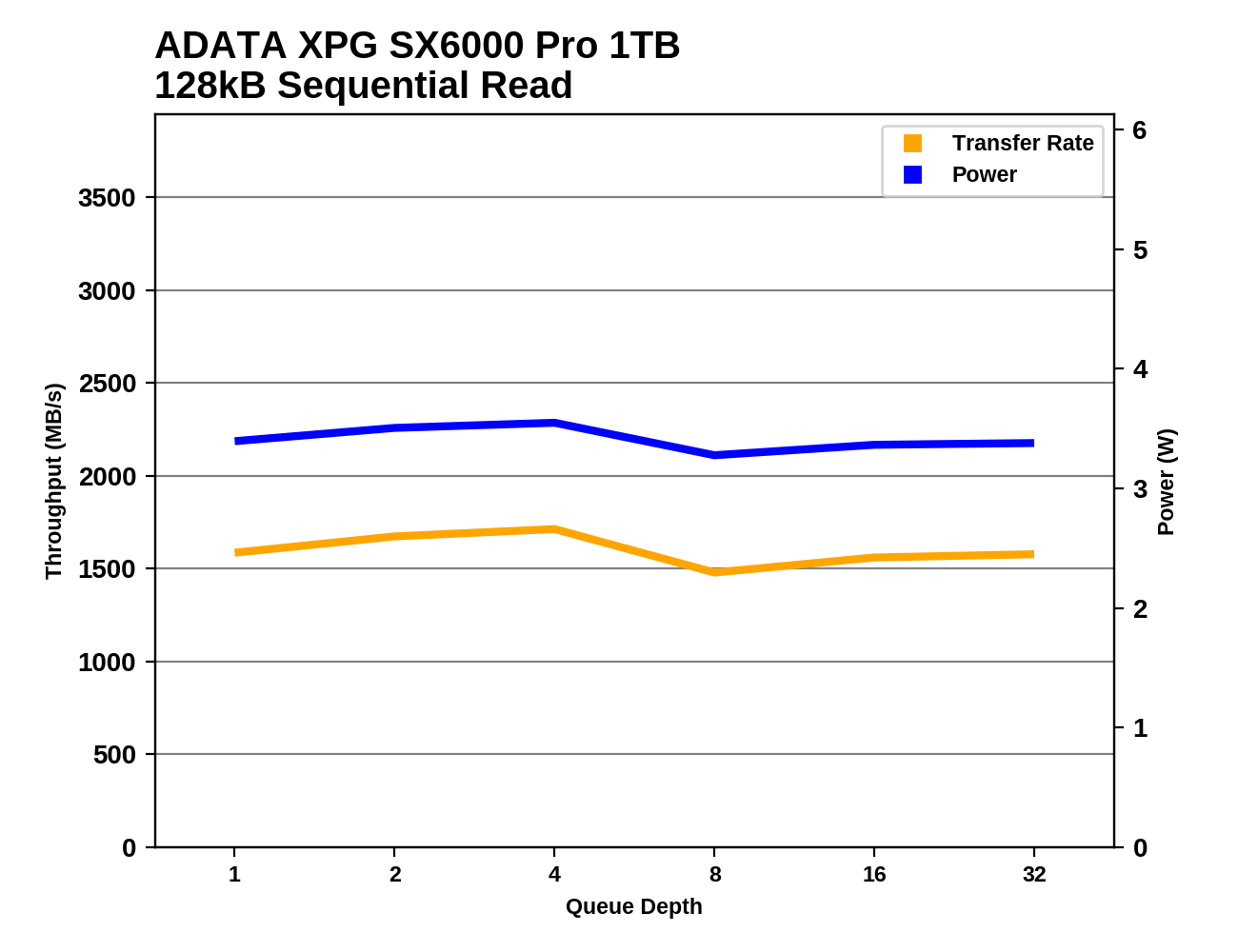 |
|||||||||
The sequential read performance of the SX6000 Pro dipped at QD8 and didn't fully recover before the end of the test, so even at high queue depths it doesn't attain the rated 2.1GB/s and instead is stuck closer to 1.5GB/s. The Mushkin Helix-L also showed a slight performance dip during the second half of the test, but it recovered and had no further trouble maintaining full speed.
Graphed against the whole database of results, the SX6000's power efficiency seems fairly middle of the road. The performance could have been achieved with a PCIe 3 x2 connection, but that's still pretty much par for entry level NVMe drives.
Sequential Write Performance
Our test of sequential write burst performance is structured identically to the sequential read burst performance test save for the direction of the data transfer. Each burst writes 128MB as 128kB operations issued at QD1, for a total of 1GB of data written to a drive containing 16GB of data.
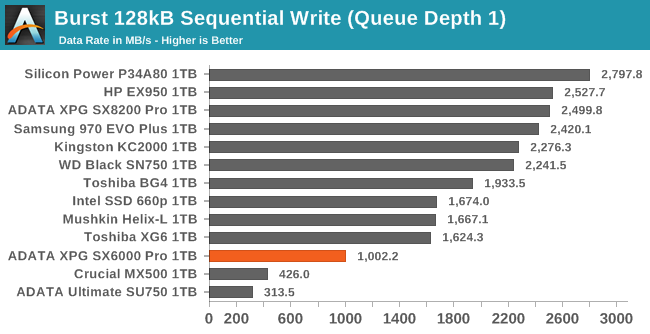
The SX6000 Pro is by far the slowest NVMe drive on the burst sequential write test, only managing 1GB/s compared to 1.6GB/s or more for other entry-level NVMe drives.
Our test of sustained sequential writes is structured identically to our sustained sequential read test, save for the direction of the data transfers. Queue depths range from 1 to 32 and each queue depth is tested for up to one minute or 32GB, followed by up to one minute of idle time for the drive to cool off and perform garbage collection. The test is confined to a 64GB span of the drive.
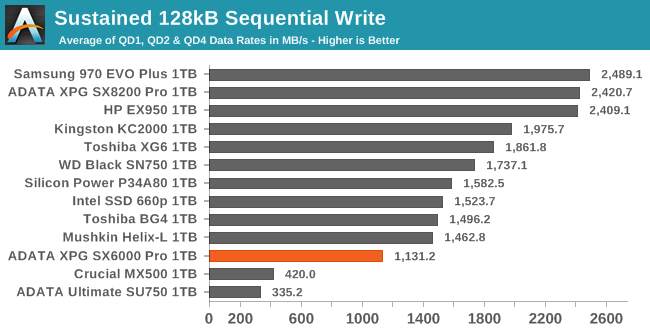
On the longer sequential write test that also includes some higher queue depths, the SX6000 Pro's score improves slightly, while the other low-end NVMe drives slow down a bit due to the higher volume of writes in this test. There's still a substantial gap between the SX6000 Pro and the rest of the NVMe drives, but it's much smaller than the SX6000 Pro's lead over SATA SSDs.
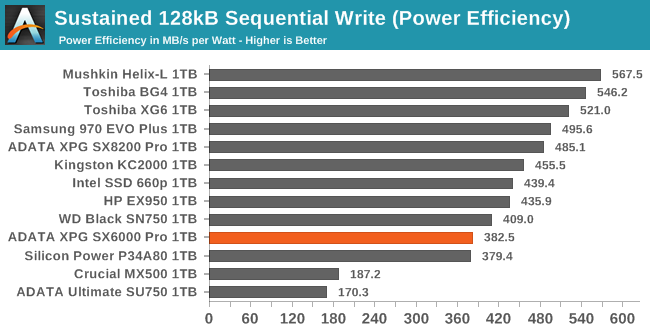 |
|||||||||
| Power Efficiency in MB/s/W | Average Power in W | ||||||||
The SX6000 Pro is tied for worst power efficiency among these NVMe SSDs, but it's still providing twice the performance per Watt of a SATA drive. The other two DRAMless NVMe drives take the top two spots for power efficiency on this test.
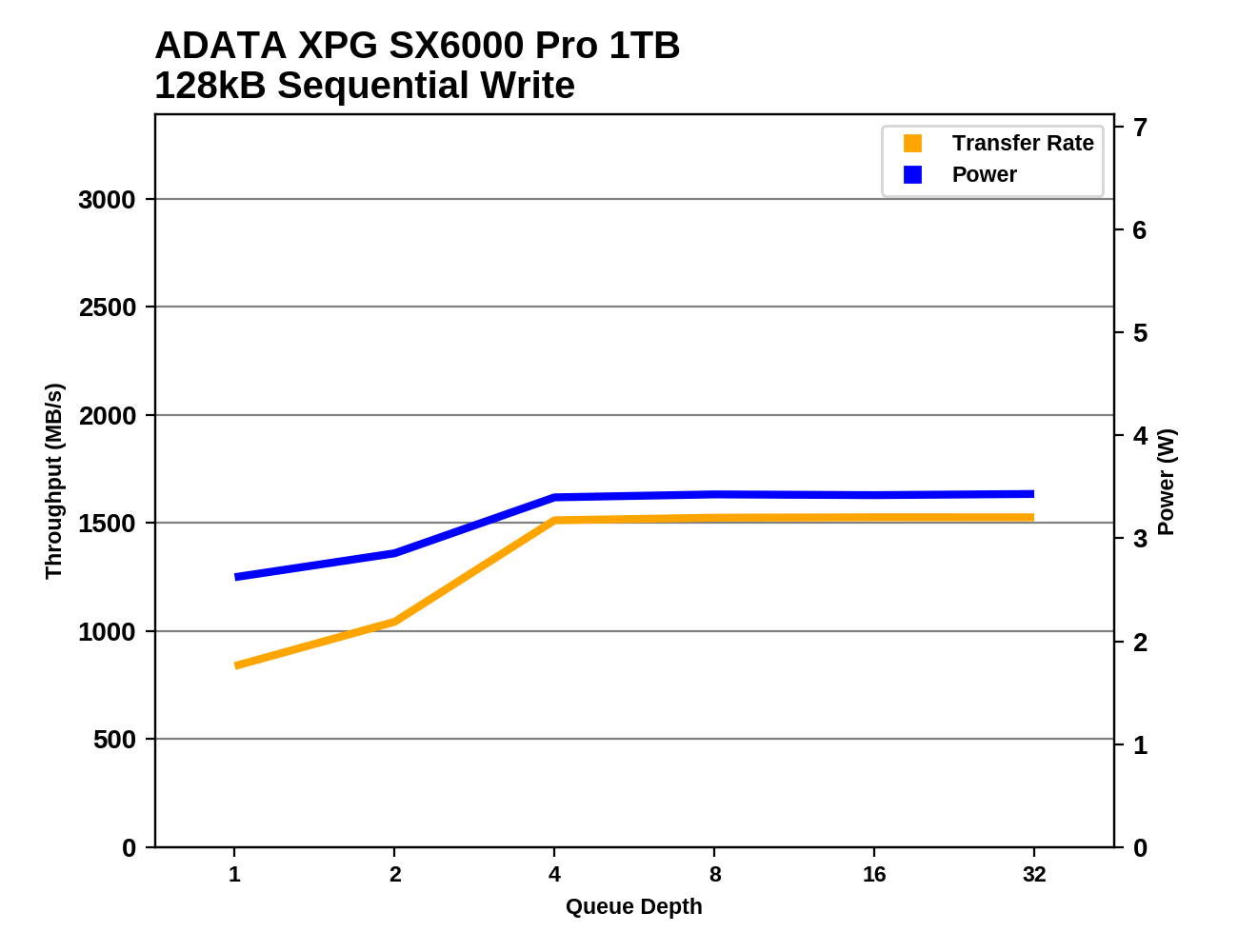 |
|||||||||
The SX6000 Pro doesn't hit its full sequential write speed until QD4, while the Mushkin Helix-L and Toshiba BG4 both saturate at QD2, and the BG4 has a clear speed advantage at full speed. The ADATA SU750 didn't manage to reach full speed until QD8, so clearly Realtek's NVMe controller has some advantages over their SATA controller.
As with sequential reads, the power efficiency of the SX6000 Pro doesn't look too bad when graphed against our entire library of SSDs, but there's definitely room for improvement. At high enough queue depths, the performance gets up to near the same levels that most entry-level or outdated high-end NVMe drives offer, and the drives that are substantially faster are mostly high-end models from the past one or two generations.
Mixed Random Performance
Our test of mixed random reads and writes covers mixes varying from pure reads to pure writes at 10% increments. Each mix is tested for up to 1 minute or 32GB of data transferred. The test is conducted with a queue depth of 4, and is limited to a 64GB span of the drive. In between each mix, the drive is given idle time of up to one minute so that the overall duty cycle is 50%.
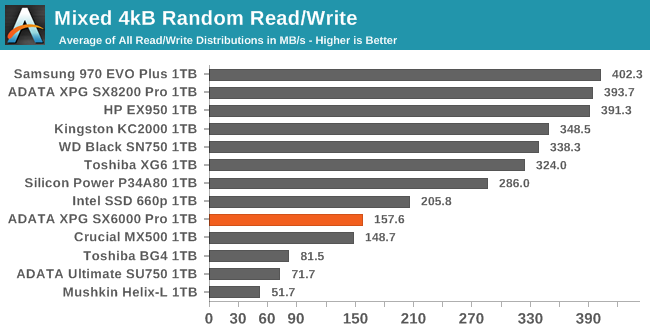
The DRAMless SSDs all perform poorly on the mixed random IO test, but the ADATA XPG SX6000 Pro is by far the fastest of them, and the only one that outperforms the Crucial MX500 mainstream SATA SSD. The Mushkin Helix-L manages to be slower than even the ADATA SU750 DRAMless SATA SSD.
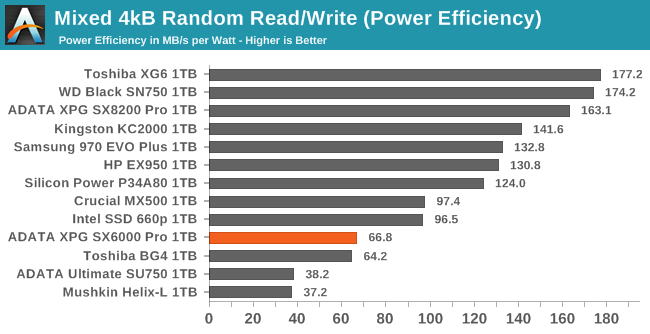 |
|||||||||
| Power Efficiency in MB/s/W | Average Power in W | ||||||||
Unsurprisingly, the SX6000 Pro and other DRAMless SSDs turn in the worst power efficiency numbers for the mixed random IO test. Most of them don't draw all that much power, but they're so much slower than the high-end drives that their efficiency scores are several times smaller.
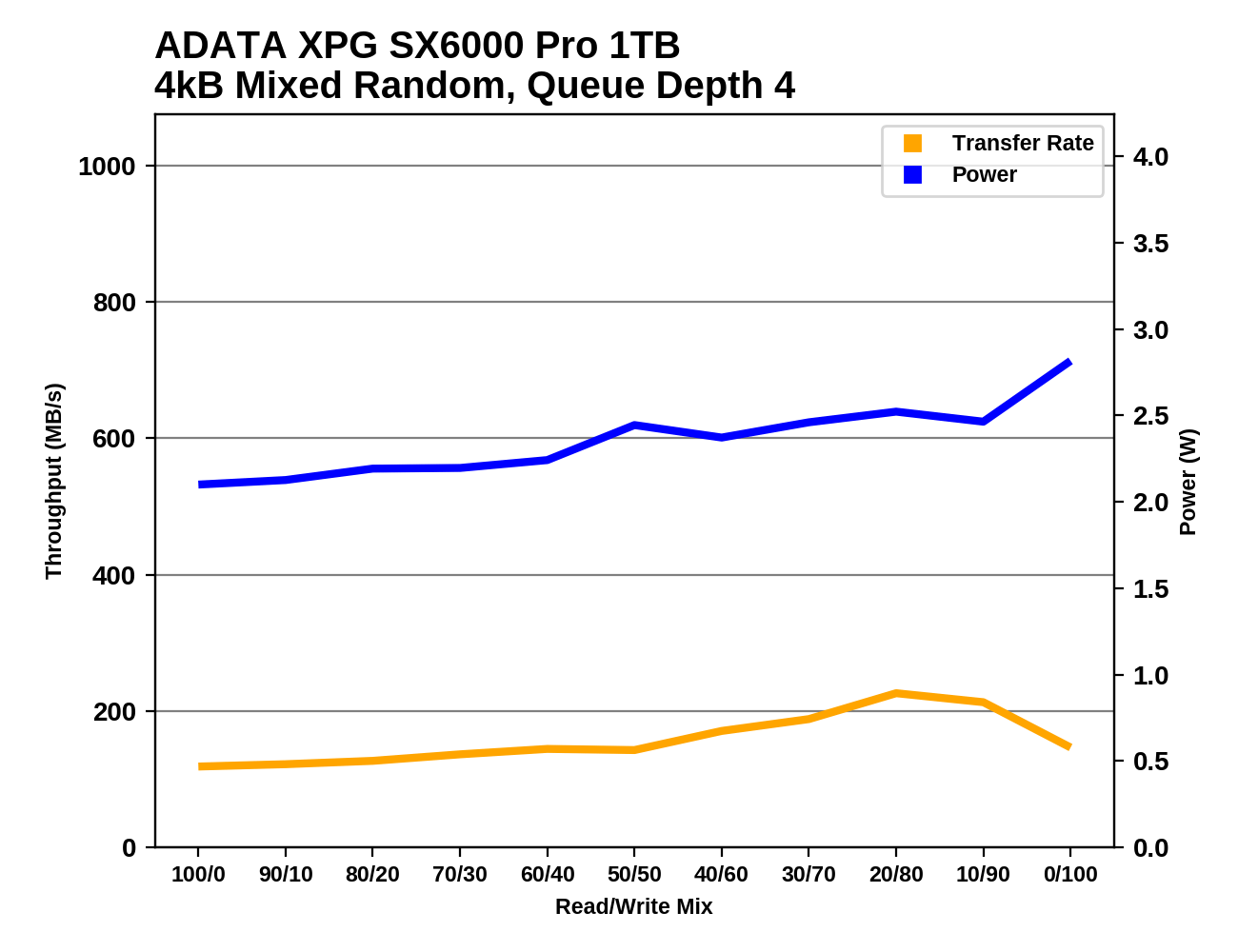 |
|||||||||
The performance of the SX6000 Pro grows slowly as the workload mix shifts from read-heavy to write-heavy. Toward the end, performance drops and power consumption spikes, indicating that the SLC cache ran out, but the SX6000 Pro almost made it to the end of the test without slowing down. The other DRAMless NVMe drives have fairly flat performance across the entire test, and definitely don't handle the write-heavy half anywhere near as well as the SX6000 Pro.
Mixed Sequential Performance
Our test of mixed sequential reads and writes differs from the mixed random I/O test by performing 128kB sequential accesses rather than 4kB accesses at random locations, and the sequential test is conducted at queue depth 1. The range of mixes tested is the same, and the timing and limits on data transfers are also the same as above.
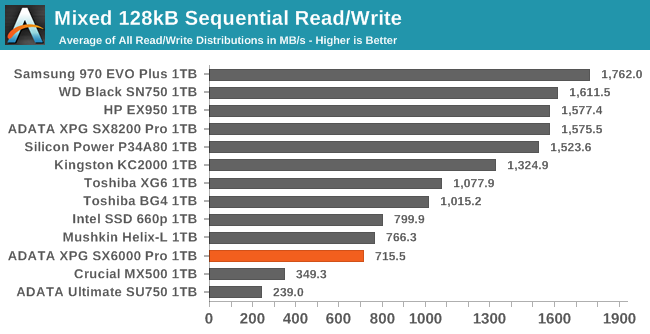
The ADATA XPG SX6000 Pro may have turned in respectable results for the individual sequential read and write tests, but on the mixed sequential IO test it is the slowest NVMe drive in the bunch.
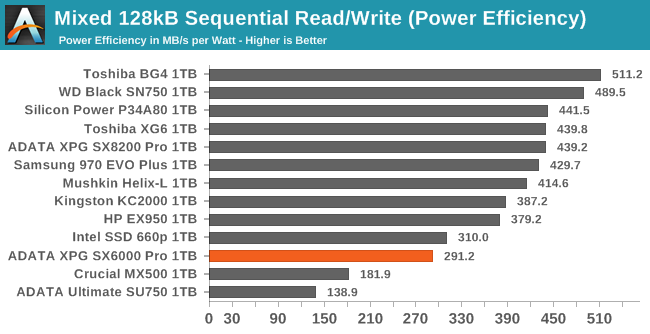 |
|||||||||
| Power Efficiency in MB/s/W | Average Power in W | ||||||||
In addition to being at least a bit slower than competing low-end NVMe drives, the SX6000 Pro draws substantially more power than the other DRAMless SSDs, so it has a relatively low efficiency score while the Toshiba BG4 tops the charts and the Mushkin Helix-L scores about par.
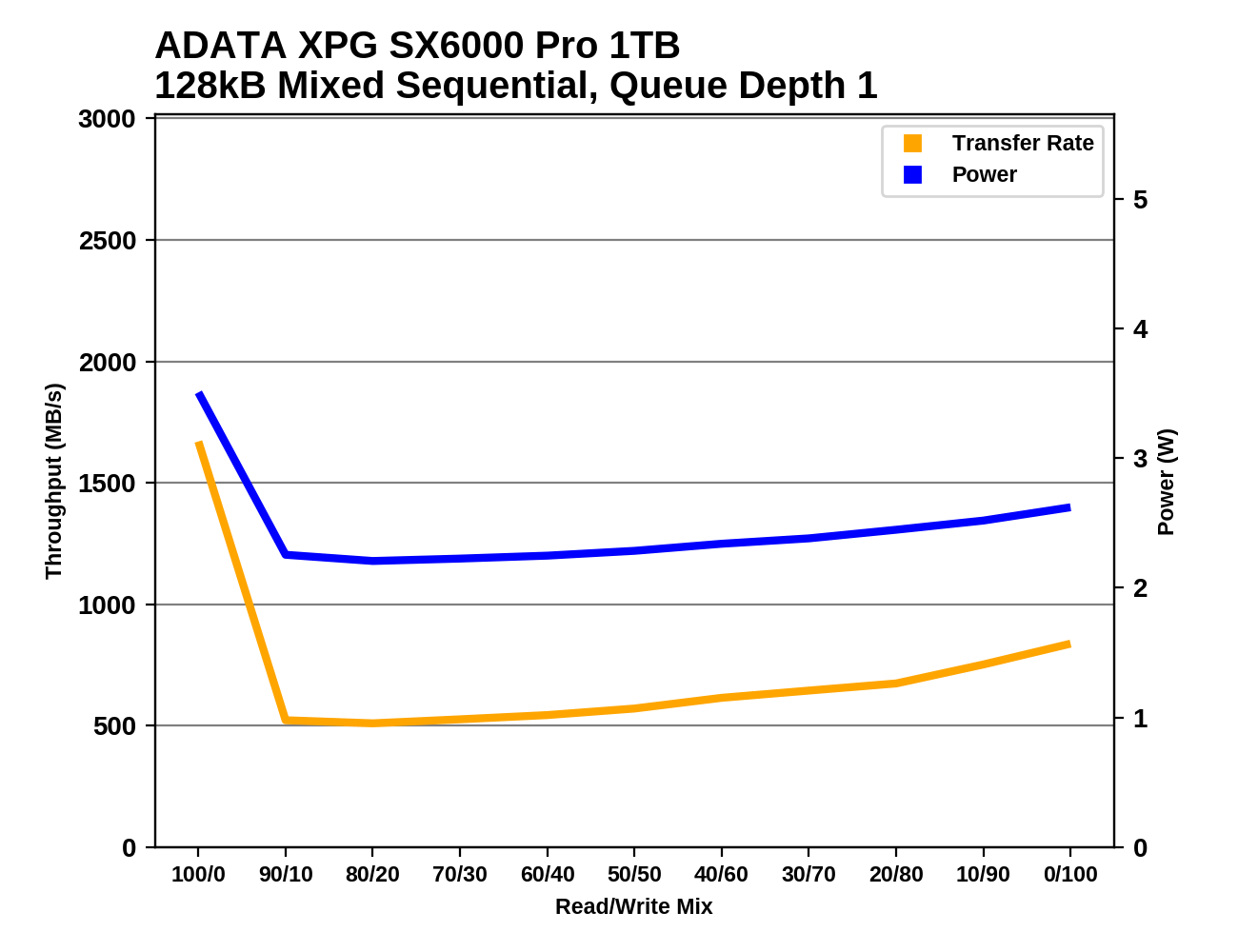 |
|||||||||
The sequential read speed of the SX6000 Pro is fine, but performance drops steeply as soon as any writes are added to the mix. Through the rest of the mixed sequential IO test, performance increases very slowly, and the SX6000 Pro doesn't get the typical performance spike at the end when the workload shifts to pure writes.
Power Management Features
Real-world client storage workloads leave SSDs idle most of the time, so the active power measurements presented earlier in this review only account for a small part of what determines a drive's suitability for battery-powered use. Especially under light use, the power efficiency of a SSD is determined mostly be how well it can save power when idle.
For many NVMe SSDs, the closely related matter of thermal management can also be important. M.2 SSDs can concentrate a lot of power in a very small space. They may also be used in locations with high ambient temperatures and poor cooling, such as tucked under a GPU on a desktop motherboard, or in a poorly-ventilated notebook.
| ADATA XPG SX6000 Pro NVMe Power and Thermal Management Features |
|||
| Controller | Realtek RTS5763DL | ||
| Firmware | V9001c19 | ||
| NVMe Version |
Feature | Status | |
| 1.0 | Number of operational (active) power states | 3 | |
| 1.1 | Number of non-operational (idle) power states | 2 | |
| Autonomous Power State Transition (APST) | Supported | ||
| 1.2 | Warning Temperature | 118°C | |
| Critical Temperature | 150°C | ||
| 1.3 | Host Controlled Thermal Management | Not Supported | |
| Non-Operational Power State Permissive Mode | Not Supported | ||
The ADATA SX6000 Pro declares comically high warning and critical temperature thresholds which we don't believe for a minute, but we are inclined to believe that thermal throttling is a pretty remote possibility for this drive. It doesn't implement either of the relevant NVMe 1.3 power and thermal management features, but only one of those two is commonly found on competing drives.
The SX6000 Pro's firmware claims to have two idle power states that are both very low power, with reasonably fast transition times. This doesn't match up with ADATA's published spec sheet, which only claims that the drive can get down to about 140mW at idle.
| ADATA XPG SX6000 Pro NVMe Power States |
|||||
| Controller | Realtek RTS5763DL | ||||
| Firmware | V9001c19 | ||||
| Power State |
Maximum Power |
Active/Idle | Entry Latency |
Exit Latency |
|
| PS 0 | 8 W | Active | - | - | |
| PS 1 | 4 W | Active | - | - | |
| PS 2 | 3 W | Active | - | - | |
| PS 3 | 12.8 mW | Idle | 4 ms | 8 ms | |
| PS 4 | 8.0 mW | Idle | 8 ms | 30 ms | |
Note that the above tables reflect only the information provided by the drive to the OS. The power and latency numbers are often very conservative estimates, but they are what the OS uses to determine which idle states to use and how long to wait before dropping to a deeper idle state.
Idle Power Measurement
SATA SSDs are tested with SATA link power management disabled to measure their active idle power draw, and with it enabled for the deeper idle power consumption score and the idle wake-up latency test. Our testbed, like any ordinary desktop system, cannot trigger the deepest DevSleep idle state.
Idle power management for NVMe SSDs is far more complicated than for SATA SSDs. NVMe SSDs can support several different idle power states, and through the Autonomous Power State Transition (APST) feature the operating system can set a drive's policy for when to drop down to a lower power state. There is typically a tradeoff in that lower-power states take longer to enter and wake up from, so the choice about what power states to use may differ for desktop and notebooks, and depending on which NVMe driver is in use. Additionally, there are multiple degrees of PCIe link power savings possible through Active State Power Management (APSM).
We report three idle power measurements. Active idle is representative of a typical desktop, where none of the advanced PCIe link or NVMe power saving features are enabled and the drive is immediately ready to process new commands. Our Desktop Idle number represents what can usually be expected from a desktop system that is configured to enable SATA link power management, PCIe ASPM and NVMe APST, but where the lowest PCIe L1.2 link power states are not available. The Laptop Idle number represents the maximum power savings possible with all the NVMe and PCIe power management features in use—usually the default for a battery-powered system but rarely achievable on a desktop even after changing BIOS and OS settings. Since we don't have a way to enable SATA DevSleep on any of our testbeds, SATA drives are omitted from the Laptop Idle charts.
Note: Earlier this year we upgraded our power measurement equipment and switched to measuring idle power on our Coffee Lake desktop, our first SSD testbed to have fully-functional PCIe power management. The below measurements are all new, and are not a perfect match for the older measurements in our previous reviews and the Bench database.
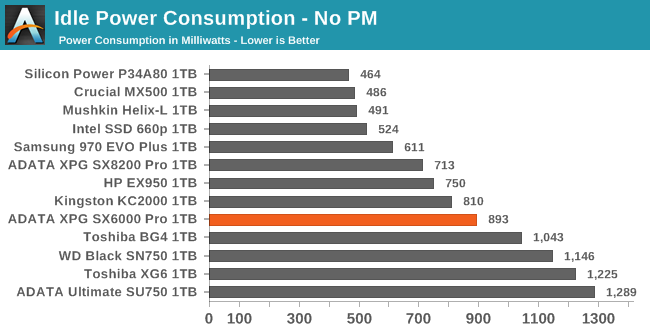
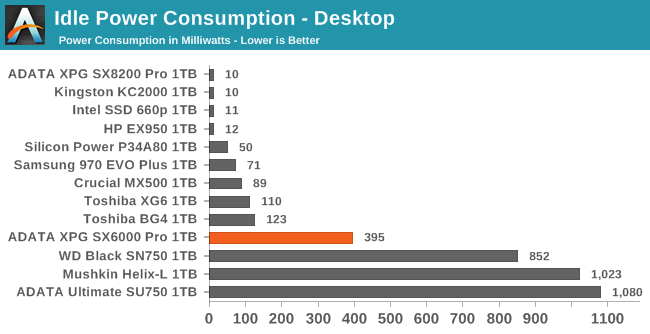
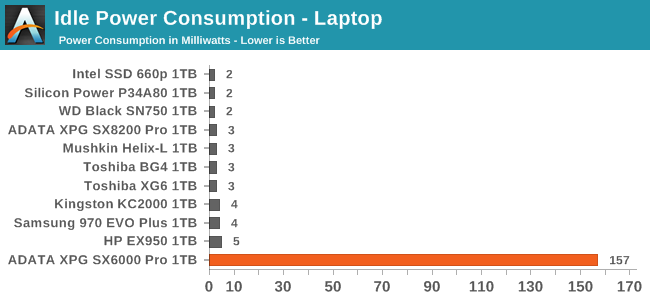
ADATA's spec sheet proves to be more accurate than the drive's own firmware when it comes to idle power draw; the controller's deepest sleep states don't really work, and the lowest power levels we observed from the SX6000 Pro are more in line with pre-DEVSLP SATA drives. We really aren't surprised to see Realtek stumble here since literally everyone else in the industry has had trouble with this at one time or another. This is nowhere near the worst case of broken SSD power management we've seen. We wouldn't really recommend the SX6000 Pro for mobile use, but its power management should be fine to keep idle temperatures low during desktop use.
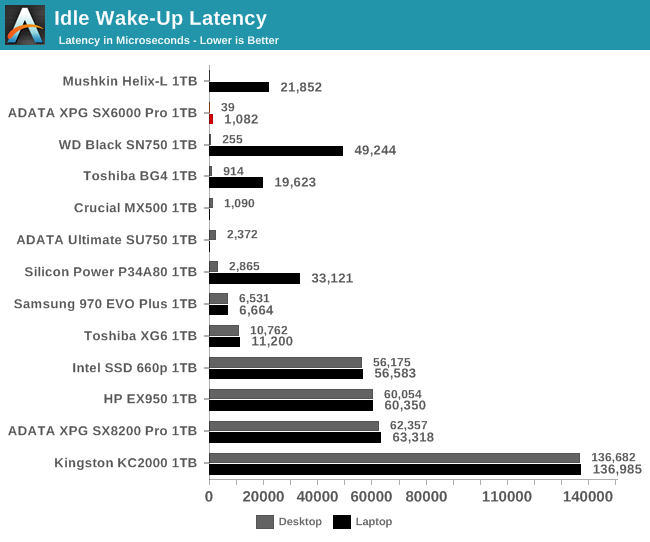
Since the SX6000 Pro doesn't actually get into any particularly deep sleep states, it's nice to see that it has extremely fast wake-up times; there's basically no downside to using the power management capabilities this drive does have working.
Conclusion
The ADATA XPG SX6000 Pro offers decent performance for an entry-level NVMe SSD. Its performance profile is a bit atypical: peak performance is definitely lower than most of its competitors (especially drives using Silicon Motion controllers), but in most cases the SX6000 Pro handles our harder tests better than expected. This is surprising because the SX6000 Pro takes the approach of using the largest SLC cache sizes possible, which is usually a way to optimize for peak performance.
The SX6000 Pro is still clearly an entry-level NVMe SSD and not a high-end drive, so it does have its performance pitfalls. But they're not as bad or as easy to run into as most other drives in this product segment. The SX6000 Pro slows down a ton if you keep writing to it after the SLC cache fills up, but given enough idle time it will clean things up and go on to provide better performance with a full drive than any of its competitors. It's ill-suited to workloads like video editing, but for more typical desktop usage it reliably outperforms SATA SSDs by a wide margin.
So Realtek's second-generation NVMe controller has overcome the performance limitations of their first attempt, and is now ready to grab some market share as the mainstream consumer storage market moves on from SATA.
Realtek is however definitely still new to the storage game, and their controller platform still has some rough edges. The power management situation for their RTS5763DL controller is seriously disappointing. We usually see DRAMless SSDs turning in some of the lowest power consumption numbers thanks to the reduced part count, and where they have reasonable performance that translates to excellent efficiency scores. The SX6000 Pro never gets close to having great efficiency; at best it manages to be about average. Under load, it often ends up delivering less than half the performance per Watt of other DRAMless NVMe SSDs that have similar overall performance.
The SX6000 Pro also fails to provide idle power management suitable for mobile use. It does have some ability to reduce power at idle so it isn't in danger of overheating from typical interactive workloads, but for a laptop its competitors are 30x better in their deepest idle state. On the bright side, the power management situation for this Realtek controller is less broken than a lot of the early NVMe controllers we saw from other vendors, so they have less to fix with their next generation.
Overall, if it weren't for the power consumption, the SX6000 Pro would be a fairly strong competitor within this low-end NVMe segment. But this is also the least-compelling product segment of the overall SSD market: these drives are still usually more expensive than mainstream SATA SSDs, and jumping up to a true high-end NVMe drive doesn't add much to the price tag.
| 240-256GB | 480-512GB | 1TB | |
| ADATA XPG SX6000 Pro | $39.99 (16¢/GB) |
$77.88 (15¢/GB) |
$119.99 (12¢/GB) |
| ADATA XPG GAMMIX S5 | $39.99 (16¢/GB) |
$109.99 (11¢/GB) |
|
| Mushkin Helix-L | $36.99 (15¢/GB) |
$56.99 (11¢/GB) |
$104.99 (10¢/GB) |
| HP EX900 | $36.99 (15¢/GB) |
$56.99 (11¢/GB) |
$120.17 (12¢/GB) |
| Kingston A2000 | $39.99 (16¢/GB) |
$59.99 (12¢/GB) |
$159.00 (16¢/GB) |
| Crucial P1 | $67.57 (14¢/GB) |
$99.99 (10¢/GB) |
|
| Intel 660p | $64.99 (13¢/GB) |
$108.99 (11¢/GB) |
|
| Intel 665p | $124.99 (12¢/GB) |
||
| WD Blue SN500 | $43.99 (18¢/GB) |
$54.99 (11¢/GB) |
|
| WD Blue SN550 | $69.99 (28¢/GB) |
$89.99 (18¢/GB) |
|
| ADATA XPG SX8200 Pro | $49.99 (20¢/GB) |
$69.99 (14¢/GB) |
$147.99 (14¢/GB) |
| HP EX950 | $71.99 (14¢/GB) |
$126.99 (12¢/GB) |
|
| Mushkin Pilot-E | $67.99 (14¢/GB) |
$129.99 (13¢/GB) |
|
| Samsung 970 EVO Plus | $69.99 (28¢/GB) |
$99.99 (20¢/GB) |
$197.48 (20¢/GB) |
| Silicon Power P34A80 | $41.99 (16¢/GB) |
$62.99 (12¢/GB) |
$114.99 (11¢/GB) |
| WD Black SN750 | $62.99 (25¢/GB) |
$79.99 (16¢/GB) |
$196.00 (20¢/GB) |
The low-end NVMe market is currently plagued by inconsistent availability and pricing, so it's hard to get a clear picture of how the products rate against each other in terms of overall value. Most of these drives are relatively low-volume products compared to the high-end models from the same brands, and the Intel and WD drives are currently transitioning between generations. But in spite of all of that, the ADATA XPG SX6000 Pro and the related GAMMIX S5 (with a heatsink) collectively offer pricing in the right ballpark for this segment, but it's undercut at every capacity by drives like the Mushkin Helix-L. The SX6000 Pro is also facing pressure from above in the form of cheap Phison E12 drives, with the Silicon Power P34A80 currently offering some of the lowest prices. That provides far better performance and power efficiency for little or no added cost.
The ADATA XPG SX6000 Pro shows that Realtek is making a lot of progress with their SSD controllers, but they aren't quite ready to steal a lot of market share from Silicon Motion and Phison as of yet. They've almost caught up, but they will need to offer SSD controller platforms with compelling advantages in order to entice drive vendors away from their existing partnerships.

